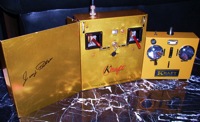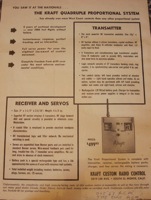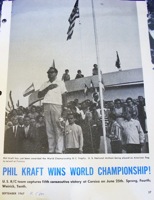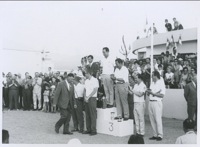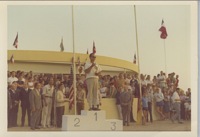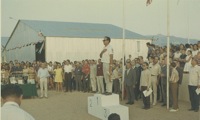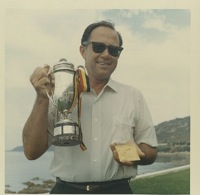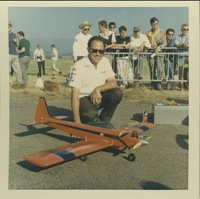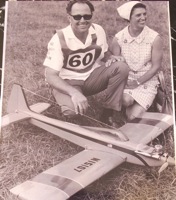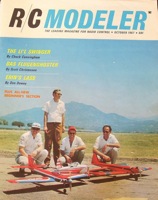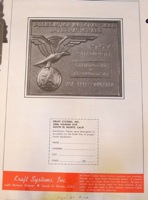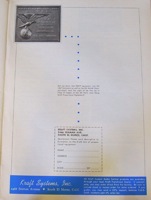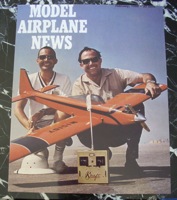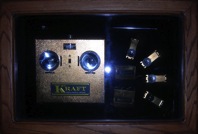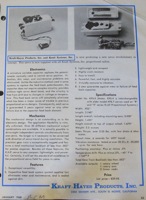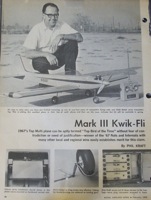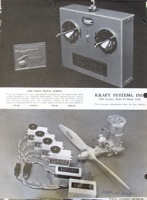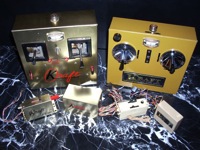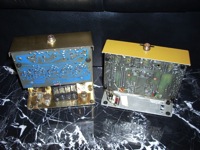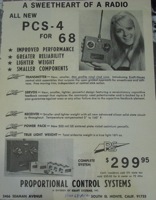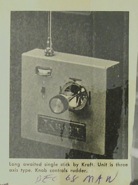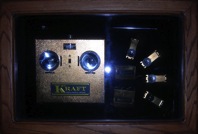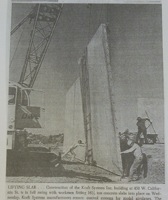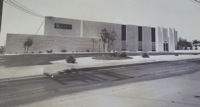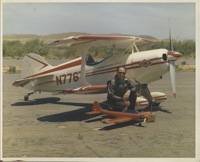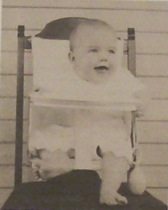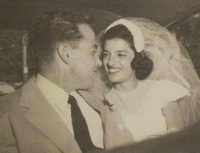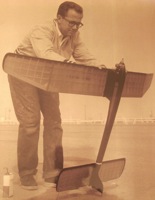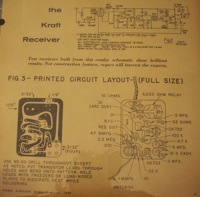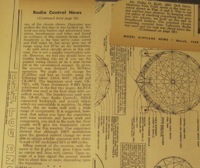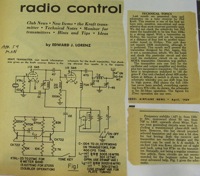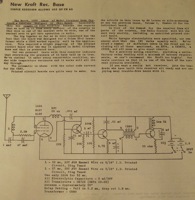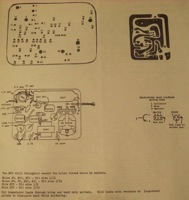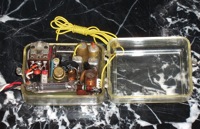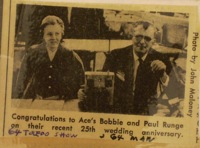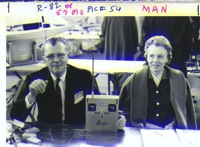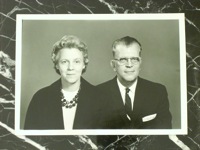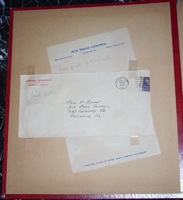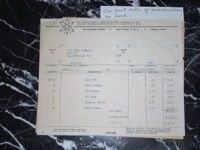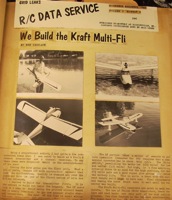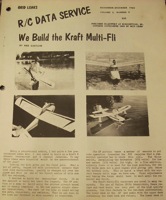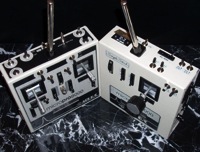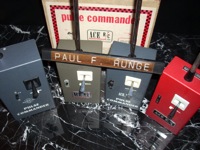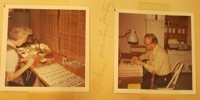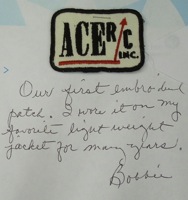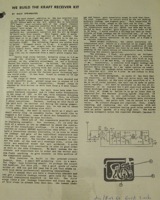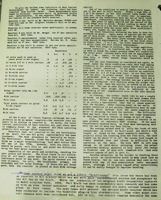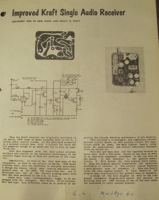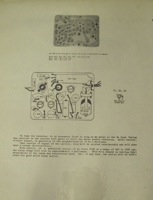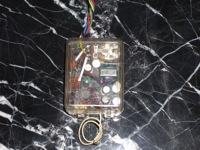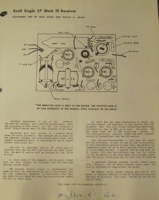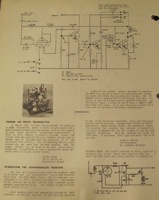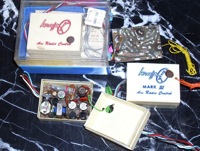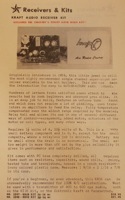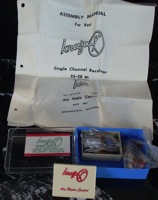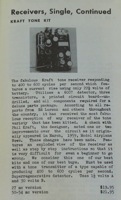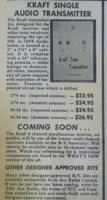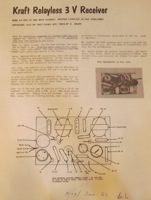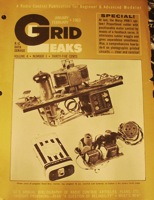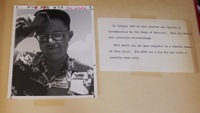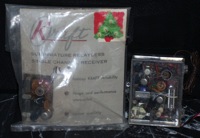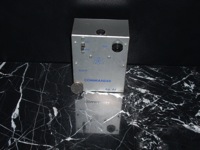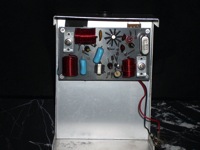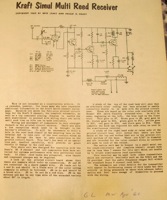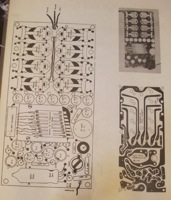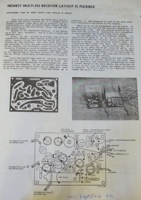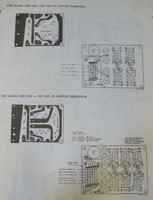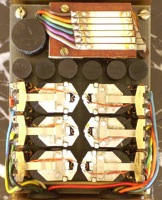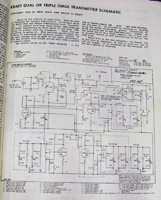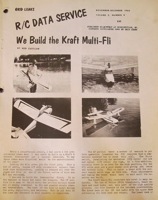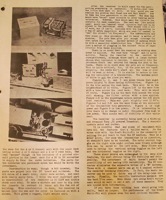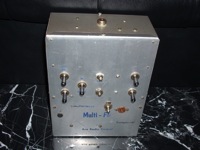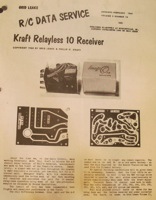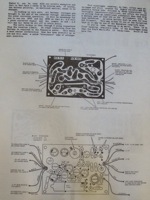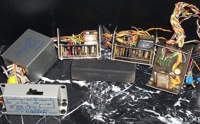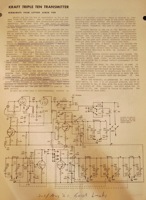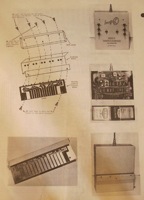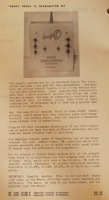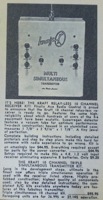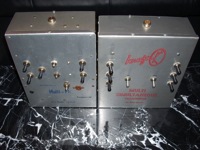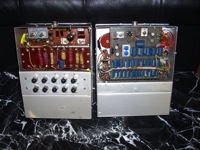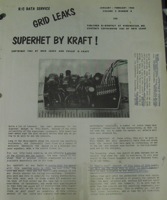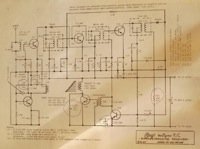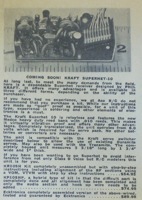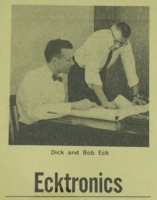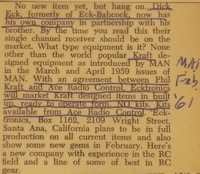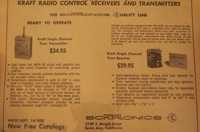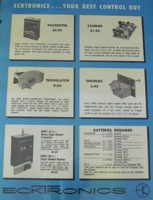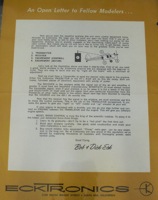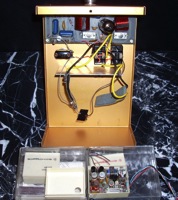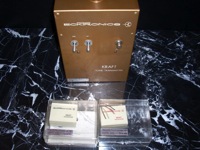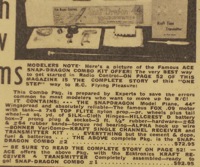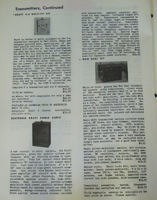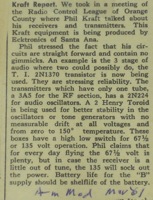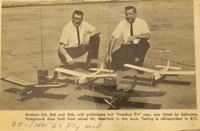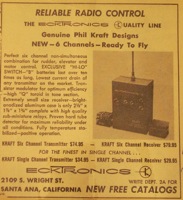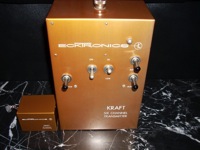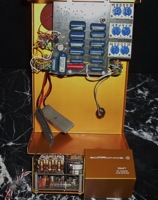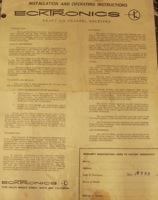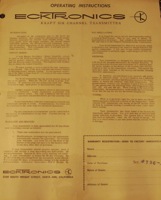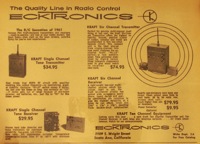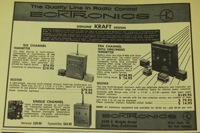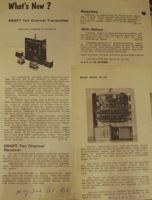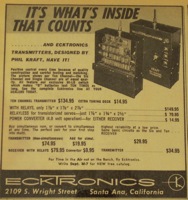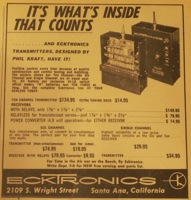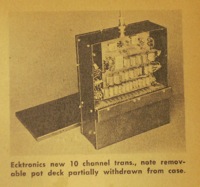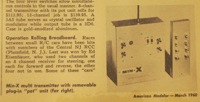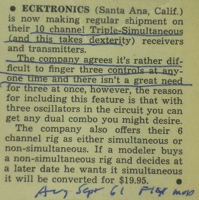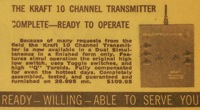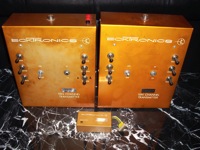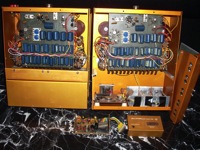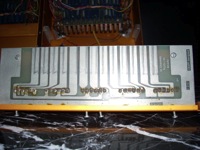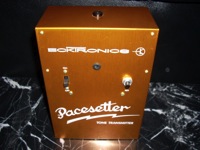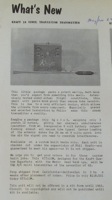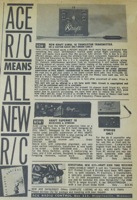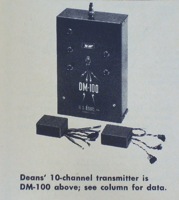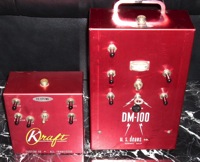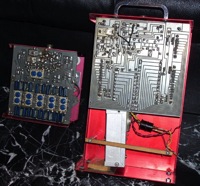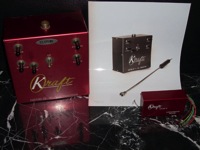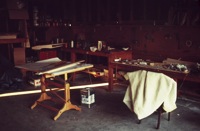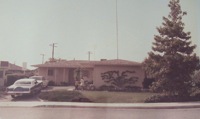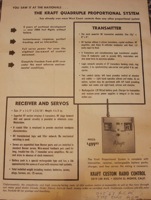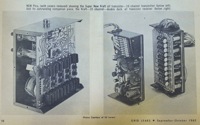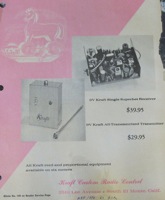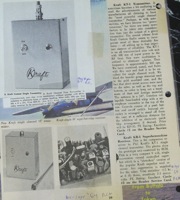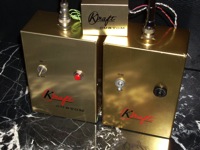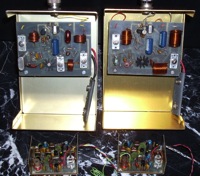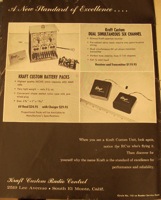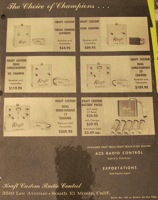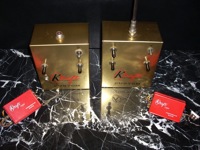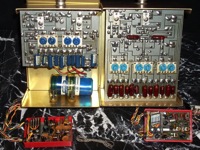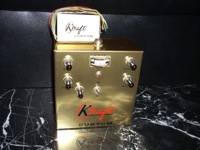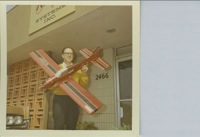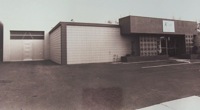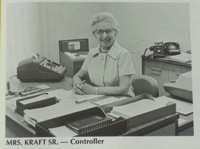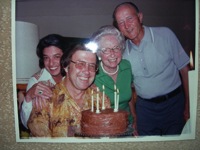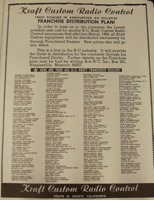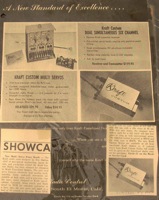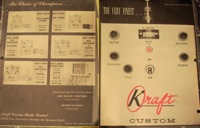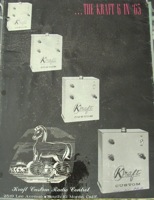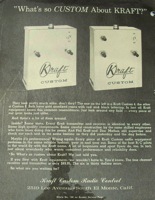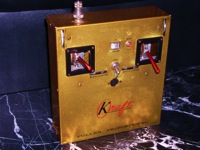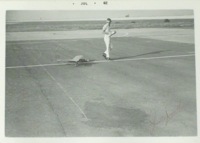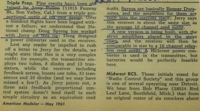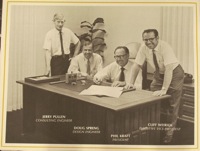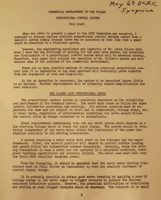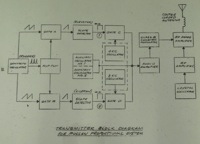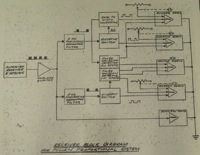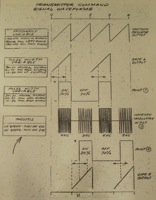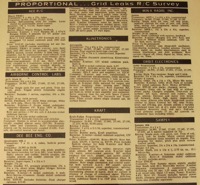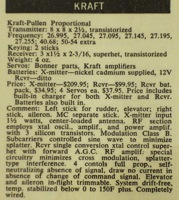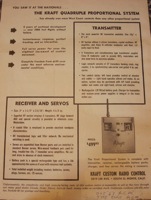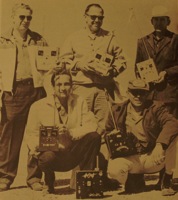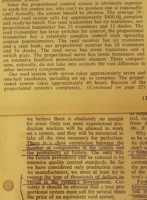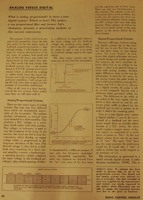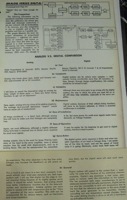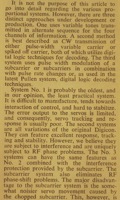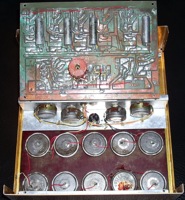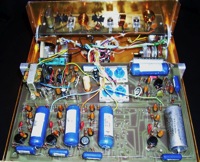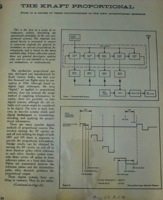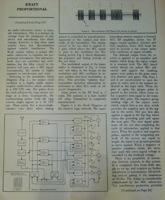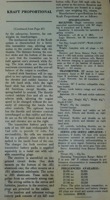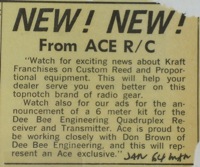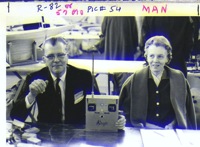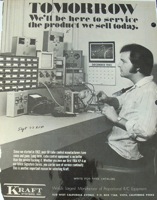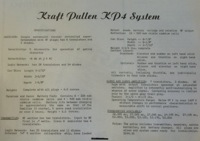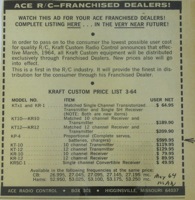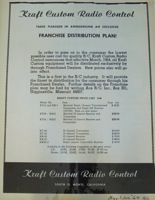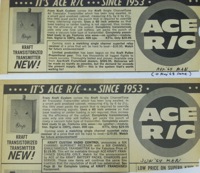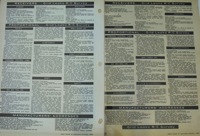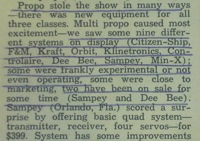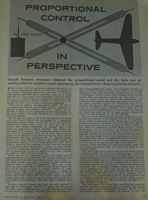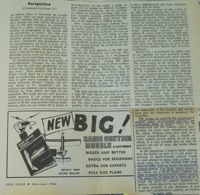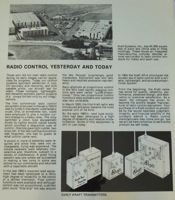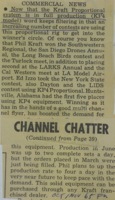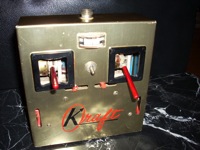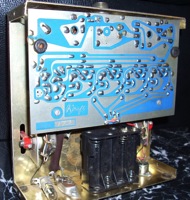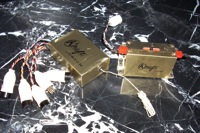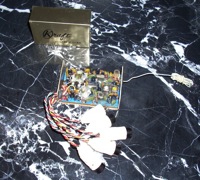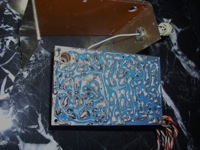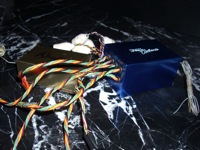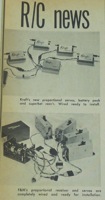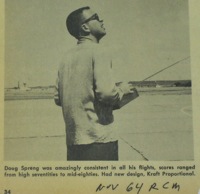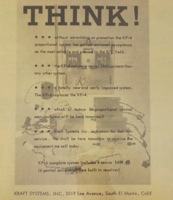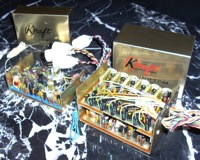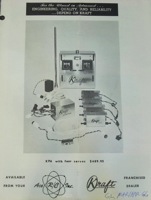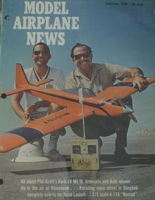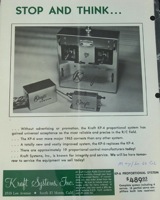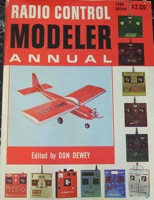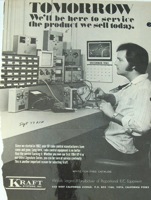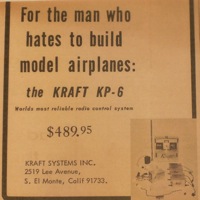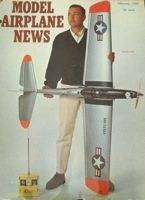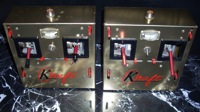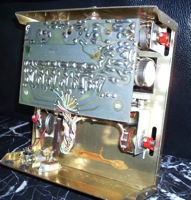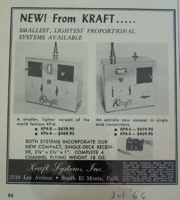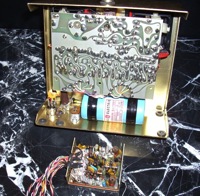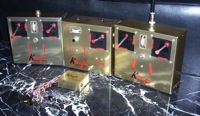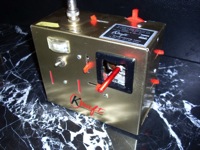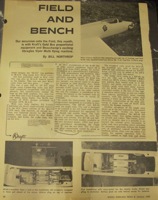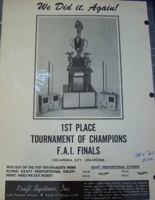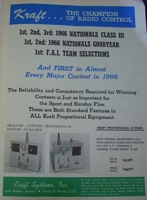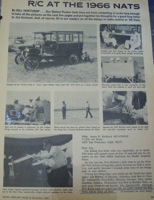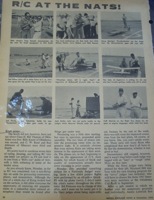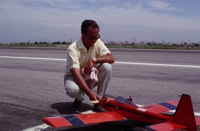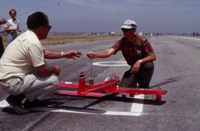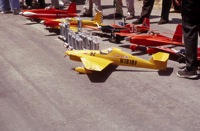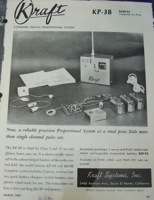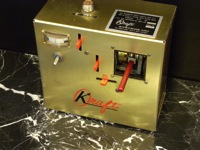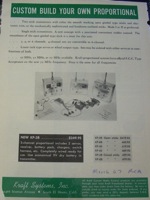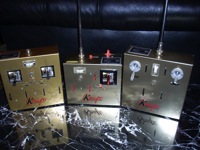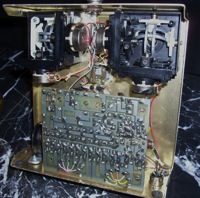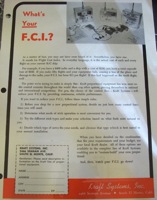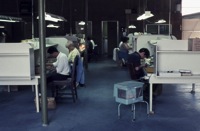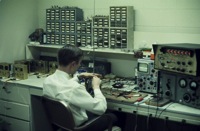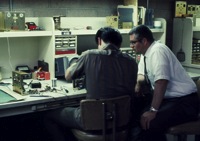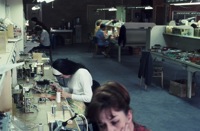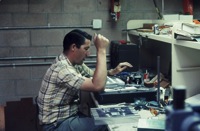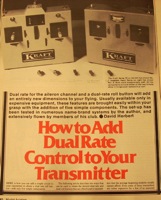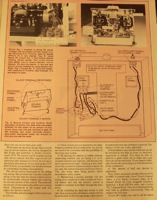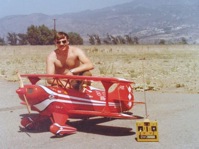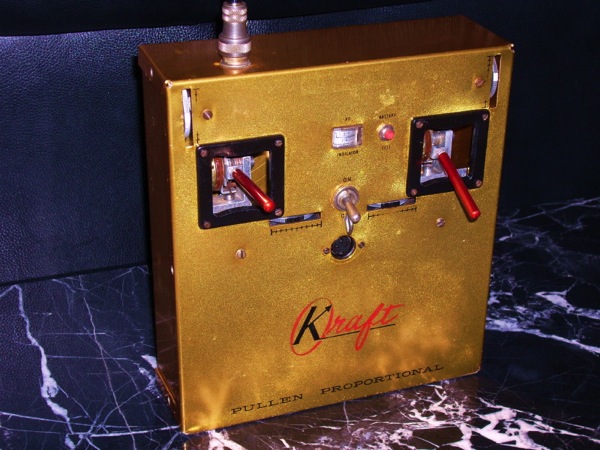Special Exhibit:
First Kraft Proportional
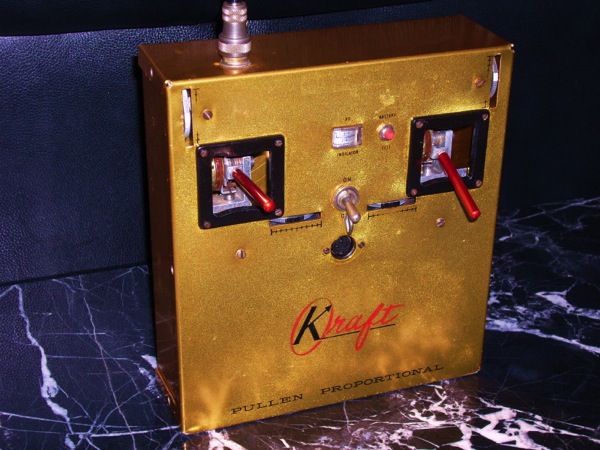
(Click on any of the images on this page to see a larger version)
Kraft spent years and copious sums of money on the Pullen Proportional Project. It culminated with this radio photographed for this, the first ever advertisement for a Kraft proportional system: Despite setbacks, frustrations and outright failure, Phil Kraft knew this project was worth whatever time and expense it took. He understood that proportional control was the future of RC, and that the first to attain the Third Dream of Radio Control on a commercial scale would be rewarded with great wealth.
And he was. But not from this radio. As the complexity and production cost of the Kraft Pullen spiraled upward during development, Kraft was forced to raise its price again and again until it exceeded six thousand dollars! (in 2009 dollars). Not surprisingly, few, if any, were ever sold or even made. This was the first.
The First Kraft Proportional.
Due to the unusual level of interest in this particular manufacturer, we will present some Kraft history before telling the amazing tale of the Kraft Pullen, below. Although only a partial history of Kraft, our account will endeavor to go well beyond anything ever written before on this subject. It will also include details and photos never before seen by the modeling public.
So where to start? At the beginning? Not this time. We’ll begin the Kraft story in the middle.
1967.
Corsica.
Phil Kraft On Top Of The World
Here is Phil Kraft on top of the World (Sept 67 RCM): He had just won the RC World Championship on the Island of Corsica, off the coast of France. He stood on the highest of three platforms like an Olympian, while the U.S. National Anthem played, French Air Force jets screamed past in salute, and he was presented the Gold Medal. Kraft was floating so high on this victory, that platform wasn’t really necessary.
At that moment, he stood atop the world in TWO ways, either of which his peers would have given anything for. First, he was the number one pilot in the world. Top Gun. The guy with the Right Stuff, and more of it than anyone else. Second, Kraft had just become the number one RC radio manufacturer in the world. How sweet it was.
Behind his ear-to-ear grin was the conviction that, even if some might argue Kraft wasn’t yet the biggest and best manufacturer, all would very soon concede this. And the reason was where he stood at that moment, and what he held in his left hand.
No, not the trophy. That Cup was a revolver that each champ would surrender after one year to the next. Look closer and you’ll see what’s much more valuable. Here’s a clearer picture from the Kraft family album:
What was really precious was that little square medallion. Kraft’s Gold Medal. Money can’t buy this nor can luck. There was only one way Phil Kraft could achieve his commanding point score lead over the second and third place French and German fliers. Hard work. Kraft practiced for YEARS, hour after hour, month after month, and he entered contest after contest. Gradually, his skill level increased and the wins started to come in.
All manufacturers tried to get their radios into the hands of champion flyers, hoping for wins which could be publicized to boost sales. Eventually, Phil Kraft didn’t really need the help of famous flyers anymore, since he became one himself.
By the time he reached Corsica he was truly the best in the world. And it showed. He not only won, he won big. Unlike previous Internationals, where the lead shifted back and forth, Kraft took the lead at Corsica on the first day and held it by a comfortable margin throughout the three day ordeal. His triumph was enhanced by his doing it with his own Kraft proportional radio and an airplane he designed and built himself.
Here’s a close up of his Championship Kwik-Fli III: This plane used a three year old Kwik-Fli II wing but with an upright engine, lower thrust line, deeper rear fuselage and much larger rudder area that the Kwik-Fli II. Here’s Mr. and Mrs. Kraft with the winning Kwik-Fli:
Gold Medal Dividends
He would have done it all for love of the sport alone, driven by his competitive instincts. But there was something more. He was a shrewd businessman and knew his hard-earned Gold Medal could be turned into real gold— worth many, many times the Medal’s weight in solid gold.
Before founding his RC company, Kraft worked for a big firm as a Manufacturer’s Representative specializing in promotion. He knew that a first place win using a Kraft radio could be capitalized on to promote sales. His fervent hope was that one of the U.S. team members who flew Kraft at Corsica would win the Gold. He even allowed himself, on occasion, to dream that it might be him. Here’s the entire U.S. team, in color, from the cover of the October, 1967 RCM:
Left to right, that’s Doug Spreng, Cliff Weirick and Phil Kraft, with Team Leader Jerry Nelson standing.
The plan to turn the Gold Medal into real gold had 2 stages. First, the win and Medal would be featured in general Kraft advertising to boost sales of existing radios. Second, he would work with Jerry Pullen (who now was employed full time for Kraft as Chief Engineer) to develop an all- new line of radios to be called the Gold Medal Series. And that’s exactly what he did.
When Phil Kraft returned to his office to discuss this with Jerry he was greeted with 70 new orders. As he walked into the main manufacturing area, the employees went wild. They received him like the returning hero he was, lavishing him with cheers, cakes and other delicacies. Many personally thanked him for the victory. They knew it meant Job Security. Phil thanked his dad for everything, especially constructing the giant, elaborate container that got his plane to Corsica undamaged.
He was also greeted by a wave of golden publicity. The Top of the World Triumph picture above (Sept 67 RCM) appeared in full page glory a month before the magazine could even get out the article about the event. In that same issue, Kraft ran this full page, inside cover ad: When had any manufacturer’s ad ever said so much by saying so little? The Gold Medal said it all.
Here’s how that Gold Medal looks today, flanked by its bronze and silver brothers from subsequent Internationals:
The next month another full page ad appeared featuring the Gold Medal and combining it with Phil Kraft’s first place win at the ’67 Nationals and the fact that Kraft proportional equipment won an incredible 8 of the first 10 places (Oct 67 RCM): Kraft’s winning record was untouchable, and ads like these used it to spur sales of his existing radios in anodized aluminum cases with open gimbals (see history below) while Kraft prepared to roll out a new, modernized system.
Gold Medal Series
The first hint of the coming new Kraft system was this ad for the servos (Jan 68 RCM): These servos came in new plastic casings made by Chuck Hayes’ company in conjunction with Kraft. They introduced variable capacitor feedback in an attempt to overcome the problems of traditional potentiometers and were guaranteed for five years. Both circular and linear offtakes were provided for unsurpassed flexibility in installation. In this era before servo reversing, they claimed this eliminated the need to care about direction of servo travel during installation.
In April, 1968, Model Airplane News carried this new product report displaying the Gold Medal and commenting on how the transmitter was only 2 inches thick (Apr 68 MAN): That same month, RCM had this article on the new radio (Apr 68 RCM): This reviewer was impressed with the small size and light weight of the airborne components. As was common in those days, he placed a cigarette pack in the picture so readers could appreciate the small servo size compared to this then-ubiquitous standard.
Gold Medal Series Turns To Real Gold
Concurrently, a third product announcement appeared in American Aircraft Modeler (Apr 68 AAM): Note the price of $450 for the standard six channel set, which would be the same as $2,800 today. Two thousand eight hundred dollars for each set sold. With reduced unit production costs resulting from the high volume Kraft was able to command, it’s easy to see how the Gold Medal Series became a gold mine for Phil Kraft.
Profits were enhanced by simultaneously offering a lower priced alternative through Proportional Control Systems, or “PCS” (Feb 68 RCM): The PCS 4 channel system was essentially the same as the Gold Medal, inside, but sold for $100 less. This enabled Kraft to expand sales to many additional modelers who could not afford the Gold Medal Series. Initially presented as a new company headed by Cliff Weirick (champion flyer) and Jerry Pullen (star engineer), by late 1967, PCS advertising acknowledged that the company was just a division of Kraft, as seen in this ad.
Kraft introduced a single stick version in late 1968, and continued to advertise and sell the Gold Medal Series through 1968 and most of 1969 until the Series Seventy was introduced. Sales were so large that Kraft ads were able to claim it was the most popular, biggest selling RC radio in the world, and that Kraft was now the world’s largest radio control manufacturer (see ads below). All exactly as envisioned by Phil Kraft at Corsica when he stood on top of the world.
The Gold Medal Series was such a success that Kraft was presented with this commemorative set, coated with real gold:
As the profits poured in, more and more employees were hired and Kraft was running out of space. In 1968, they bought 7 acres in Vista, California and constructed a new, much larger factory. Kraft Systems moved its operations there in early 1969. Phil Kraft moved his family to a big house on a hill in nearby Oceanside and most of the employees moved to Vista as well so there was no loss of talent or disruption of production.
Kraft’s stellar success story was a matter of pride in his community , as evident in these local press accounts:
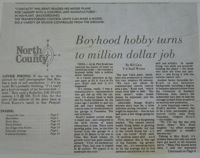 | 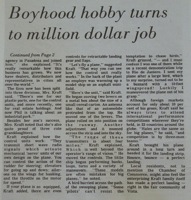 | 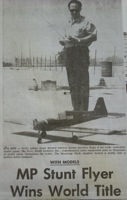 |
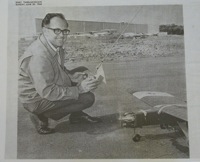 | 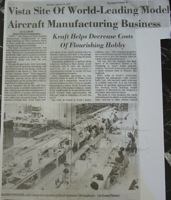 | 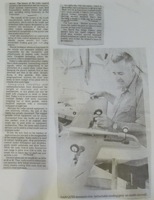 |
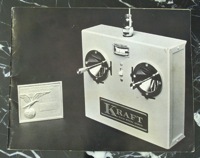 | |
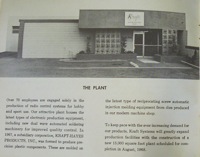 | 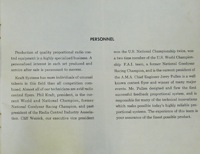 |
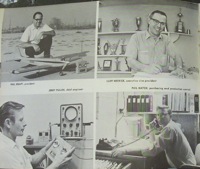 | 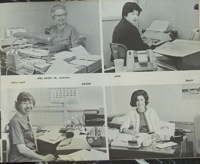 |
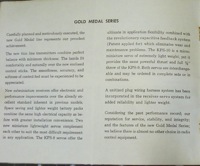 | 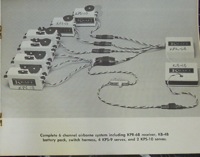 |
Gold Collage
Phil Kraft posed for this picture with his own Gold Medal Series radio plus one of his full scale toys. Here is a collage of full page advertisements for the Gold Medal Series from 1968 and 1969. These ads contain some nuggets of important information, but for the most part say surprisingly little. They don’t have to. The Gold Medal continued to speak more eloquently than any words.
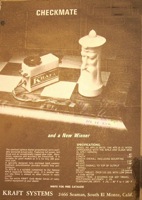 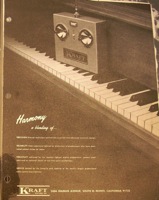 | 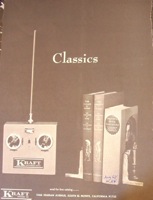 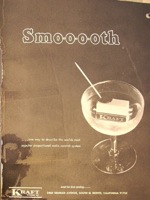 |
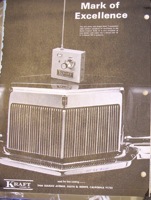 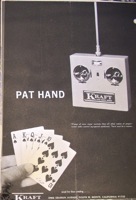 | 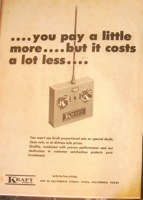 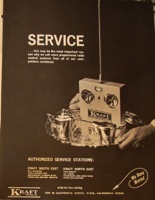 |
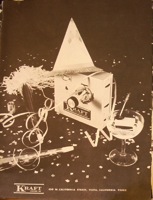 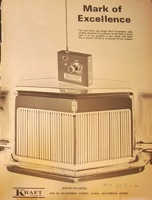 | 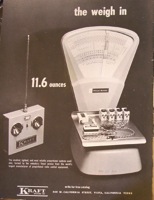 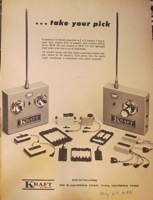 |
Having seen Phil Kraft on Top of the World, let’s now look at how he got there. Phil and his company weren’t always industry giants bathed in a golden glow. Their origins are much more modest, and about as small as you can get.
The Beginning
Phil Kraft was born April 18, 1926, but the beginning of our story was really in 1935. That’s when his Dad performed a service to the model airplane hobby performed by so many other Dads before and since. He bought 9 year old Phil a free flight model with a Dennymite 7 engine, and hooked him on model airplanes for life.
That ship was followed by another, then another, and in 1939 Phil Kraft began entering free flight contests. And he began to win. For years, he won every contest he entered in the under 16 category. Then, a second trait emerged which would serve him well in later years; he began designing his own planes.
He joined the Navy in 1944 as the end of World War was coming into view. Phil was stationed at a base near Orlando, Florida where he serviced the famous P.B.Y. amphibious aircraft and had some exposure to electronics.
After the war he earned a college degree (business administration), married Lillian Rae Archer, had three daughters and worked on establishing his family and work life. Around 1953 he returned to modeling and resumed his winning ways at free flight. But he grew increasingly tired of seeing his creations drift away or collide with trees and other objects.
Captured By First Dream
Phil Kraft found himself dreaming more and more about how much better it would be if only he could control his aircraft. That dream grew ever larger until there was room for little else in his modeling life. Phil was captivated by The First Dream of Radio Control. It would change the RC world.
He began to fly RC in 1956. Back then, the technology was so crude, and available systems so limited, that any serious RC enthusiast needed some expertise in electronics. He proceeded to teach himself the subject, propelled by the dream. The more he learned, the less he liked existing equipment. So he began to design his own radios.
National RC Debut
In 1959, Phil Kraft arrived on the national RC radio scene. By then, reeds and other multi controls (Second Dream of Radio Control) were well established and the first full-house proportional systems (Third Dream) were about to be introduced. But Phil Kraft started way below all of this. His national debut began at the very bottom, with this March, 1959 article on how to make a simple, lowly, single channel receiver (Mar 59, MAN):
The article was an immediate hit. Most flyers couldn’t afford the state-of-the-art multi systems. All they wanted was a more reliable 1 channel receiver—one they might build themselves to save money. This was it! Model Airplane News remarked how “This is NOT just another tone receiver,” how its operation was “perfect, the first time it was hooked up” and how it could be built by the average modeler. This was the first in a wave of favorable reviews which swept the country.
The next month, Model Airplane News published this article on a companion transmitter designed by Phil Kraft (Apr 59 MAN): Note their conclusions after tests: “Operation was perfect” “It is for experts.”
Later that year the respected Grid Leaks radio control publication ran this article on the Kraft receiver, modified to use the preferred CR-60 transformer (Sept/Oct 59 GL): Note their comment that the Kraft design “caught on like wildfire.” Here’s an actual first Kraft receiver with the CR-60 modification:
Grid Leaks was a publication of Ace Radio Control, the iconic American radio control company owned by Paul and Loberta (“Bobbie”) Runge.
Meet The Runges
Model airplane News ran this photo of the Runges on the occasion of their 25th Wedding Anniversary (Jun 64 MAN):
But why are the Runges appearing in this history of Kraft and the Kraft Pullen Proportional? The best answer is to look at a clearer picture of the Runge's Anniversary. Here is the original photo used by Model Airplane News for their June ,1964 edition ( National Model Aviation Museum, Model Airplane News Collection):
That's right, Paul and Bobbie Runge were celebrating their 25th Anniversary at the 1964 Toledo Trade Show while they tried to sell the Kraft Pullen Proportional! ("production" version shown here) Beginning with Phil Kraft's first receiver design in 1959, he and the Runges had a mutually beneficial relationship over many years. He helped them achieve their remarkable success and they helped him achieve his.
Their company, Ace Radio Control, manufactured, advertised and distributed kits to build Kraft- designed radios for over five years. Ace bore all the costs and risks and kept all the profits, after paying a royalty to Phil Kraft. This enabled Kraft to grow his RC sideline without leaving his day job or confronting the perils of production in his small garage (more about that garage later).
Ace Radio Control was a leading American RC company for over four decades, offering an immense and diverse product line. The Runges ranked among radio control's royalty. But they began very small and never lost their humility.
Official Ace publications and other histories of the company state it began in 1953. They actually started in 1952 in Georgia; 1953 marked the beginning of the Higginsville, Missouri operation which would grow into the world-famous RC powerhouse. Here is the first ACE letterhead and the first letter ever written to Ace. It is postmarked Dec 1952 and was from John Worth, a major figure in radio control history, active to this day. <>
Here is the invoice for Ace’s first order of merchandise for resale (Aug 10 53): And this is a hand made set up for an early Grid Leaks Kraft article alongside the actual publication (Nov-Dec 60 GL): Notice the primitive technology in those early days, including painstaking cutting and pasting of individual letters by hand.
Ace grew and grew until its catalogs were half an inch thick, or more. They always specialized in lower cost equipment for electronics experts, do it yourselfers and the masses of “common man” hobbiests on a budget. But they also sold the very highest-end equipment such as the Kraft Pullen Proportional, and later, the Ace Micro Pro computerized radios, beloved by legions of fans to this day. Ace’s greatest success may have been its simple, affordable Pulse Commander system. This radio introduced multitudes of modelers to proportional control and one of them is displayed at the Smithsonian Institution in Washington, D.C. (after our museum turned it down. No, only joking).
<>
ACE
As the interest in Phil Kraft’s radios grew in the wake of the two Model Airplane News articles, the Runges agreed with Phil to offer parts and kits for Kraft radios in return for a royalty (based on other ACE contracts we know, probably 2% of gross sales). Ace added Kraft equipment to its line August, 1959 with this small insert in a 2 page Ace advertisement (Aug 59 AM): Next came this stand-alone ad in September (Sept 59 AM):
Grid Leaks then published this article by Dale Springsted detailing the specific performance statistics which made this little receiver a “GIANT”, including small size and low weight and current drain (Jan/Feb 60 GL):
Two months later, Grid Leaks published this improved design by Phil Kraft (Mar/Apr 60 GL): Recounting how “reports on the fantastic performance” of the original Kraft came “pouring in from all sections of the country,” they unveiled this new version with many improvements. These included a lighter weight Deans relay, higher quality transistors, greater sensitivity, and the ability to follow high pulse rates. Here’s one of these improved Kraft receivers (“Mark II”) from our museum:
A year later, Grid Leaks introduced this Mark III Kraft receiver with an ST-11 transformer in a “styrene crash proof box” (May/Jun 61 GL): Although stated to represent constant improvement, the article is not clear on just what the advances were. Noteworthy is how ACE refused to publish the circuit board to protect its exclusive right to sell Kraft kits. Here are some actual Mark III’s from our museum:
Here are ads for the Kraft receiver kits in ACE’s 1961 and 1963A catalogs:
In September, 1960, Ace offered the Kraft Transmitter in kit form (Sept 60 MAN):
Here’s the Kraft Tone transmitter as presented in ACE’s catalog (1961):
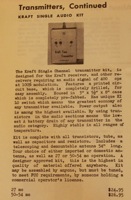
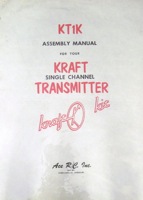
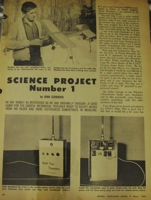
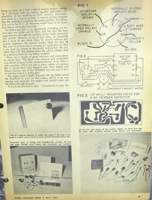
And here is an actual Kraft Tone Transmitter from our museum: 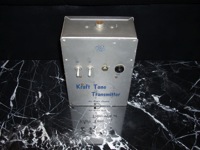
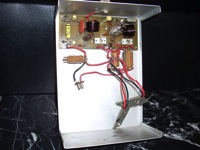
In 1962, ACE introduced a smaller lighter relayless receiver, the 3VK (May/Jun 62 GL):
This is how it looked in ACE’s ads (July 62 AM):
This tiny 3 volt receiver was not only relayless but tubeless, and it proved to be very popular.
Here are Paul Runge’s reflections on the occasion of a Phil Kraft visit in 1962:
This is an actual 3VK, never removed from its special Christmas packaging, with an earlier Kraft single channel receiver, for comparison:
By now ACE had begun to offer multi-control reed systems by Kraft, but single channel sales continued. The demand for simple, less expensive control was so persistent that ACE rolled out a new, single channel transmitter kit in 1965. Reaching deep into its nostalgic past ACE borrowed the name of its popular pre-Kraft radio the “Commander”. In a clash of extremes, this new “Kraft Commander” 1 button transmitter kit was offered at the same time as ACE advertised the sophisticated and expensive new Kraft Proportional system designed to succeed the Kraft Pullen Proportional.
Here’s an ad with both of them (Apr 65 MAN): And here is an actual Kraft Commander from our museum:
Reeds
Six months later ACE published this article about its new kit form of the Multi-Fli (Sept/Oct 60 GL): Grid Leaks couldn't even wait until Kraft finished designing the transmitter before they published it (Sept/Oct 60 GL):
It was now a 4-6 channel receiver in 2 decks with the capability of going relayless. This latter feature was not remarkable. Relays could be removed from any reed receiver with little difficulty. The challenge in going relayless was the servos, and their need for transistor amplification. Here’s how ACE presented the Multi-Fli in advertising (Sept 60 MAN) and its catalog (1961):
ACE then published this article on building the Multi-Fli (Nov/Dec 60 GL): Compare this actual Multi-Fli from our museum (10 channel): We’re not sure yet, but few Multi-Flis appear to have been sold and it was quickly replaced by the Kraft Multi Simultaneous transmitter and Relayless 10 receiver.
The best explanation at this juncture is that the Multi-Fli emerged near the end of the era of vacuum tube, relay-operated systems and Kraft and ACE quickly shifted gears and brought out a new, more transistorized, relayless radio. But, the substantially redesigned transmitter is harder to explain since all transmitters are “relayless”, the new one still had a vacuum tube and the old one was also triple simultaneous (the 10 channel, not the 6); we suspect there is more to the story. Let us know if you are aware of other problems with the Multi-Fli. For more on RC’s Rush to Relayless , see “Who Was First—First Relayless” Exhibit.
The Kraft Triple Ten Transmitter debuted 4 months later in this article (Jul/Aug 61 GL): The Triple Ten was presented like this in the ACE Catalog (1963A): As Phil Kraft’s stature rose, so did the visibility of his name on the cases. The “Kraft” logo is now much more prominent than “Ace Radio Control” and contains a transistor symbol at the end. When Kraft began his own production, this was eliminated and the “K” in Kraft turned into a stylized transistor. Here’s how ACE advertized its new multi reed system (Sept 61 AM): Notice that the Triple Ten and the Multi Simultaneous are the same. To further confuse, this transmitter has 6 switches denoting 12 channels. Why is it called a 10 channel? For the answer, look to the 2 lower switches, both labeled “Rudder”. Versatility.
Compare the new Kraft Multi Simultaneous 10 channel transmitter with its very different predecessor, the Multi-Fli:
As RC advanced, it became increasingly difficult to offer lower cost kit versions of everything. Demand for fully assembled radios out stripped demand for do it yourself kits. Kraft began to offer factory-produced, ready-made units. These came not from Kraft’s own factory (there was none) nor from ACE’s facilities, but from a third company.
Ecktronics
In mid-1960, long-time modelers Bob and Dick Eck bought Babcock, one of America’s oldest radio control manufacturers. For a few months, the Eck brothers ran Babcock and sold radios under the name “Eck-Babcock.” Then, at the end of 1960, they left Babcock to start their own business. They took the names “Eck” and “Electronics” and merged them into “Ecktronics”, as the name of their new company.
Although Dick Eck was an engineer, the brothers relied on outside experts to design their RC equipment. Since Phil Kraft’s single channel radios were “hot” then, the Ecks made him an attractive offer. Phil didn’t want to make a move that left his friends at ACE behind. In this February, 1961 article, the RC world learned that Kraft, Ecktronics and ACE had reached an agreement (Feb 61 MAN): Ace would continue to sell Kraft radio kits and Ecktronics would offer factory-built versions of the same radios, under the joint names of Ecktronics and Kraft.
The first Ecktronics ad appeared 1 month BEFORE this announcement (Jan 61 MAN): Here are 2 pages from the first Ecktronics product brochure: And this is an actual Ecktronics Kraft single channel system from our museum: Notice how Ecktronics included not only the Kraft name at the bottom, but also something quite similar to the Kraft “transistor K” logo, at the top.
Oddly, this early catalog gives a lengthy and different description of the Ecktronics Kraft as if it is distinct from the kit Kraft which ACE sold on another page. Subsequent catalogs described the Ecktronics version as being the same, only assembled and in a gold anodized case.
Also of interest here is the explanation of the Hi-Lo button on ACE and Ecktronics Kraft transmitters. This allowed low- drain operation of the expensive B battery to prolong its life; flyers would switch to high, and get five times the power and battery drain, only in emergencies. Phil Kraft explained the reliability of his radios and the advantages of the Hi-Lo feature in a presentation to the Radio Control League of Orange County (Mar 61 AM):
In late 1961, Ecktronics promoted their radios together with a suitable airplane to fly them in (Oct 61 AM): This picture shows the Eck brothers with their Kraft-designed radios and Freedom 7 aircraft (Dec/Jan 62 FM):
Ecktronics Kraft Reeds
Just one month after Ecktronics’ first single channel ads, they began offering the 6 channel Kraft reed set (Feb 61 MAN): This rig also had the Hi-Lo feature but was not simultaneous. Flyers, for example, could not command up elevator while blipping a turn. In addition to the Hi-Lo switch to reduce B battery drawbacks in the transmitter, Ecktronics offered to install a power converter for $ 9.95 to completely eliminate the heavy, on-board B battery.
Here is an actual six channel Ecktronics Kraft from our museum:
These are Operating Instructions for the Ecktronics Kraft six channel transmitter and receiver:
Just two months later, the Ecktronics Kraft ten channel arrived (May 61 AM):
ACE simultaneously introduced the new radio in this fashion (May/Jun 61 GL):
Ecktronics then goofed by releasing this ad (July 61 MAN): They had to do a lot of explaining as customers attempted to order the ten channel transmitter in non-simultaneous format for $79.95 together with the upgrade to simultaneous for an additional $19.95, as advertised. This two-step would have scored the ten channel simultaneous set for a total of $99.90 instead of $134.95. Like most things which seem too good to be true, this was. The next month, Ecktronics ran this corrected ad clarifying that the $79.95 transmitter was a 6 channel model (Aug 61 FM): Don't forget the headline: "It’s Whats Inside That Counts" This appears again in Kraft advertising. Did Kraft borrow Ecktronic's slogans or did Kraft design their ads as well as their radios?
More Features
In this product review you can see the featured removable pot deck (Oct 61 MAN): Ten tone pots were mounted in a row across the back of the transmitter on a removable plate. Additional plate modules (“tuning decks”) could be purchased for $14.95 so that the same transmitter could be used with different receivers in different planes by interchanging tuning decks instead of laboriously retuning the 10 pots each time. This feature appears to have been “borrowed” from Min-X, as documented by this much earlier Min-X product review (Mar 60 AM):
When Ecktronics promoted their ten channel system to Flying Models magazine, discussions revealed how the triple simultaneous feature was of questionable value (Aug/Sept FM): ACE also had to defend this feature against requests by modelers for less expensive Kraft Ten kits with dual simultaneous or no simultaneous.
In October, 1961, two articles appeared revealing that Ecktronics would now sell a simpler Kraft Ten Channel for $109.95 instead of$134.95. (Oct 61 AM; and Oct/Nov 61 FM): This cheaper Kraft Ten would offer only dual simultaneous operation and drop the interchangeable tuning pots. Within months, these diminished, cheaper Kraft Tens became the only type offered by Ecktronics (Jan 62 AM):
Here are two Ecktronics Kraft radios from our collection: Both are the $134.95 triple simultaneous type with interchangeable tuning modules. One has a power converter. Here is a close up of the pot module:
Falling Out
By 1962, Kraft and Ecktronics decided to part company. Phil Kraft later told friends this was his idea because he believed the quality of the Ecktronics Kraft line was inferior and damaging to his reputation. We are not sure if this involved Ecktronics’ discounting and diminishment of the ten channel transmitter as described above, or something more. Research continues. One additional factor was probably Phil’s growing desire to do his own production and run the business himself now that his reputation and confidence had grown.
The Eck brothers could hardly have quarreled with this, since it was the path they followed when they left Babcock to form their own company. Also, the Ecks had evidently decided on their own to focus on less expensive equipment for the larger “hobbyist” market, instead of more advanced radios for the “expert” market. The parties agreed that Ecktronics would stop making Kraft reeds, but continue selling the Kraft single channel radio, at least for a limited time. Ecktronics and ACE were also allowed to sell their remaining stock of Ecktronics Kraft reed equipment, provided the Kraft name was removed. On our examples displayed above, this was done by placing silver frequency stickers over “Kraft”.
Curiously, Ecktronics continued to use the Kraft-like “transistor K” logo alongside its name on all equipment until the very end.
Missing Link?
In 2011 we found this. It may be the missing link between Ecktronics Kraft and Kraft Custom. You can see from the inside picture the resemblance to the Ecktronics line. But there is no denying the discrepancies. Anyone with additional information on this is urged to contact us at once. The possibility that Phil Kraft's first independent RC line was not Kraft Custom needs resolution.
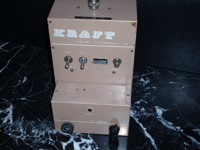 | 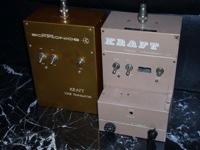 | 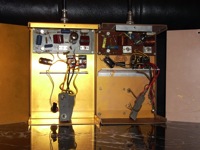 |
Kraft Custom
As Phil Kraft celebrated New Year’s eve, 1962, he made a secret resolution to himself. His satisfaction with Ecktronics had been falling at the same time his own reputation in the RC community was rising, along with his confidence. He vowed to break free of the past and start his own business manufacturing his own line of RC radios. Early in 1962 he completed a total redesign of his reed systems making them all-transistorized, all-simultaneous and much smaller and lighter.
He named his new radios Kraft Custom. This was because , in the beginning, he produced these one-at-a-time on a custom basis for friends and fellow fliers. There was no advertising then, only word-of-mouth.
The first publicity for Kraft Custom came from his old friends, the Runges. Here is their product announcement for the Kraft Custom 10 channel (May/Jun 62 GL): In mainstream magazines (e.g. MAN and AM) ACE continued to offer only the old Kraft Triple Ten and single channel equipment. Then, in July, 1962, ACE unveiled the new, state-of-the-art Kraft Custom 10 (Jul 62 AM):
This edition of American Modeler also carried a new product announcement for the Kraft Custom 10 and, coincidentally, the new Deans reed radio (Jul 62 AM): The Deans was excellent and had won both the 1960 and 1961 Nationals (see Exhibit—First Deans?). Nevertheless, the concurrent introduction of this radio affords a dramatic comparison with the more recently designed Kraft system, highlighting how much more advanced, and state-of-the-art the Kraft Custom 10 was.
Compare this actual Kraft Custom 10 with its contemporary competitor the Deans 10 channel, inside and out:
First Factory
This garage picture was taken after production had moved to Kraft’s first El Monte, California plant. Thus, the jumble of radios, supplies and production and test equipment which had been crammed into this small space is all gone. Mrs. Kraft had waited for this day so she could park her Thunderbird Coup (in the picture), but it looks like the garage may have continued to be devoted to model airplanes.
On that drafting table, Phil Kraft designed his world-famous airplanes including the Hi-Fli, Gimlet, Bi-Fli, Stagger-Bi, Kwik-Fli I,II and III, Ugly Stik, Go-Go-Fli and Bar Fli. Could that model under construction in the background be the Kwik-Fli which won the World Championships at Corsica?
This garage was also the birth place of all early Kraft radios through and including the first Kraft-manufactured system—the Kraft Custom 10 (both engineered and fabricated there). When production began in this garage in 1962, Kraft had 4 “employees”’ all part-time: himself, a technician (probably Don Mathes), and two neighbor ladies who built sub-assemblies, mostly at their own homes.
Don Mathes had major electronic expertise but was referred to by Kraft in those days as his chief mechanical engineer. Mathes found a supplier to fabricate and anodize the transmitter and receiver cases. Evidently this shop also provided the cases and anodizing for the Deans reed radios which were designed by Don Mathes earlier but brought to the RC marketplace with the same color at the same time. That would explain the Great Red Kraft Mystery, i.e. why were early Kraft Custom radios red instead of the familiar gold?
It would have been convenient and economical for Mathes to combine the limited early production quantities of the Deans and Kraft cases into single, more substantial production and anodizing runs (think: quantity discounts). Thus, Bill Deans may have (indirectly) selected the color of the first Kraft radios. More likely, it was selected by Solidtronics Corporation, maker of the world’s first commercial proportional system—the Space Control. That’s because Mathes made his prototype Deans radios while working at Space Control and used their red color for the cases. See First Space Control and First Deans exhibits.
We suspect both Bill Deans and Phil Kraft were well aware that Mathes worked for both companies. Back then the Southern California RC community was small and close-knit; most everyone flew together and knew each other, and there was considerable in-breeding and job switching.
If the confusion and conflict of Mathes simultaneously serving these two competing companies isn’t enough for you, how about this? At the same time he was also working with Doug Spreng to form his own competing company to produce a proportional system. This resulted in the Spreng-Mathes “Digicon” , the world’s first commercial “digital” proportional and the one modern RC systems have been modeled after ever since (See Digicon chapter of C&S One exhibit).
Since Phil Kraft now had a nation-wide reputation for outstanding radio design, and the new Kraft Custom 10 was so advanced and exceptional, orders poured in at a surprising rate. More and more employees were hired.
The Plunge
After just a few months two things were obvious: One, they were unable to keep up with the influx of orders; and two, production had definitely outgrown the garage. Kraft’s response was also two-fold: First, he leased a “real plant” for production in South El Monte (2519 Lee Ave); and second, he took the plunge, quit his comfortable, high-paying corporate job and went into RC radios full time. This was a courageous and risky decision at the time, but proved to be one of the best he ever made.
To ease the transition, Kraft continued to rely on his old friends the Runges for advertising, distribution and office support. For years Kraft and his company let ACE, Ecktronics or others advertise Kraft products. There were originally two reasons why Kraft and his company did not run their own ads. Having other, larger firms do this for them was convenient and saved money. Also, in the early days of garage production, Kraft had no address to put on the ads. He didn’t want his home address advertised and thought P.O. boxes looked “fly-by-night”.
Now that Kraft Custom had a real factory with an address, advertising was considered, but not done until October, 1963. That’s when Kraft rolled out its first ever ad, for its first ever proportional in the first ever issue of Radio Control Modeler. It was a full-page, inside cover advertisement by “Kraft Custom Radio Control” but the pictured transmitter didn’t say Kraft Custom on it like all the others. It said Kraft Pullen Proportional. That ad was not repeated, but months later Kraft Custom resumed its full page ads in RCM—for Kraft Custom reeds.
In August, 1962 Model Airplane News tested a Kraft Custom 10 and found it to be “outstanding”. The reviewer commented how the light weight transmitter should eliminate fatigue during long flights (Aug 62 MAN): Next, Grid Leaks provided this inside look at the “Super New Kraft” (Sept/Oct 62 GL): Since the Kraft Custom 10 receiver was a compact single deck unit, it’s hard to explain the article’s reference to a “double deck” receiver and the picture of the second “receiver” unit on the right. Answer: The device on the right was an optional “Servo Switcher” to enable a relayless receiver like this to operate Bonner Duramites or other relay-type servos.
ACE continued to advertise the Kraft Custom 10, as the only Kraft Custom reeds available, for 7 long consecutive months. Then, in early 1963, Kraft introduced a twelve channel system (Jan/Feb 63 AM): A year later, Kraft ran this full page ad showing the inside of a Kraft Custom 12 and a Trojan Horse to emphasize it’s what’s inside that counts (Feb 64 RCM):
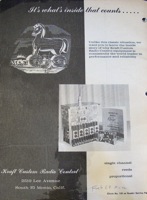
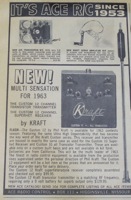
Here are actual Kraft Custom 12 radios from our Museum, first and second generation:
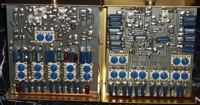
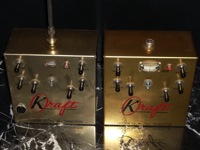
After the 12 channel, Kraft went to the opposite extreme for its next offering. In December 1963, ACE announced that a Kraft Custom single channel system would be coming soon. However, the Kraft single did not actually appear until this announcement (Mar/Apr 64): Here’s the first ad for the Kraft Custom single channel (Apr 64 MAN): Don’t miss the other Kraft radio listed beneath the single channel and costing TWO THOUSAND PERCENT MORE!
Here’s an actual Kraft Custom single channel from our museum:
Kraft’s next product was a dual simultaneous six channel reed set in May 1964 (May 64 RCM): Later in 1964 Kraft would display its complete line of Kraft reeds in full page RCM ads like this (Oct 64 RCM):
Here are actual Kraft Custom 4 and 6 channel radios as seen in these ads, and an example of what a Kraft Custom 10 looked like when it came off the assembly line:
Family To The Rescue
Kraft’s order volume continued to grow and he continued to hire more help. One night at an extended family dinner, Phil said to his Dad: “I could sure use you. Why don’t you come work for me.” Within days his Dad had quit his job and joined Kraft Custom full time, never looking back.
One day $400 was missing from a bank deposit. The woman who took the funds to the bank freely admitted taking the money, believing it was alright since she had financial problems. She didn’t even know she was stealing, and was promptly fired. Phil’s Dad said it was time to bring his Mom in. “Do you think she’d be interested?” Phil replied.
Was she. Mrs. Kraft proceeded to “crack the whip” and organize the place. It wasn’t long before she was running the operation in terms of its day-to-day business. Her skills were formidable and she may have saved the business in those chaotic start-up days. Years later, she was still firmly in control. Here’s a picture of Phil’s Mom from the 1972 Kraft catalog: And here is Phil with his wife and parents much later on the occasion of his 50th birthday:
Beginning in March of 1964, the practice of selling through ACE changed. Kraft began to advertise that all Kraft Custom equipment would be sold exclusively through Franchised Dealers, also called “ACE R/C—Kraft Franchised Dealers” (Jul/Aug 64 GL): ACE used the same dealers for its full line of products.
In early 1964, Don Mathes concentrated on improving the vital actuator component and bringing it in-house. Previously, most RC companies sold the transmitter and receiver only and left modelers to find their own servos, batteries, switches, wiring, etc. Kraft wanted to be able to sell his radios as complete systems without relying on Bonner, Annco or others for servos. In the June/July issue of Radio Control Modeler the new servos were revealed with this full page ad and product review ( Jun/Jul 64 RCM):
For some time now the color of the cases had changed from red to gold. It was symbolic of the company’s improving prospects.
By the end of 1964, Kraft had begun its tradition of lavish, full page ads, often saying very little,verbally. The implicit message in ads like these was dual: big size meant success and little text meant the “Kraft” label said enough (Oct 64 RCM; Dec 64 RCM; Jan 65 RCM):
One nagging problem just wouldn’t go away. Kraft kept having to explain why these radios were called “Custom” when the days of custom built radios for friends and club members had long past. Finally, Kraft took out this, full page ad to address the Custom Controversy (Nov 64 RCM): This explanation didn’t satisfy many modelers since it admitted the units were definitely and deliberately standardized, not custom, partly due to invaluable lessons learned on the Kraft Pullen Project.
But the Kraft Custom name soon didn’t matter since the business had grown to the point it needed to be incorporated. When this was done in 1964, the name was changed to Kraft Systems Inc. Kraft Systems continued to advertise and sell reed radios well into 1966 despite the arrival of proportional as the prime focus of Kraft and other manufacturers. And the reed sets carried the name “Kraft Custom” right to the end.
Kraft and other manufacturers became comfortable with the relatively simple, reliable and profitable reed business. They secretly pursued crash programs to develop proportional systems and secure their futures, while publicly belittling the technology and praising reeds. Phil Kraft went so far as to publish a detailed analysis of why proportional was unlikely to ever replace reeds (see next section). As wrong as he was then, this appears to have been his honest belief at the peak of his frustrations with the Kraft Pullen Project.
It was difficult for Phil Kraft and the other RC makers to be objective or see clearly on this issue. They had invested millions in reed technology and equipment and thousands of hours personally mastering the difficult art of “bang-bang” flight control. They were all very reluctant to let go and watch all this investment slide down the drain.
But it didn’t matter what they wanted.
The Age of Proportional was upon them now. The Third Dream of Radio Control was coming at them like a freight train. Every manufacturer had to get on board or be left behind.
In Phil Kraft’s case it wasn’t a train he boarded, but a roller coaster. An out-of-control roller coaster called the Kraft Pullen Proportional.
Kraft Pullen Proportional
In early 1961, just a year after Space Control ushered in the era of commercial proportional, Jerry Pullen began flying his own proportional system in California. Jerry was a top engineer at the legendary Jet Propulsion Laboratories (“JPL”). He believed proportional was the future of radio control and could provide a competitive edge enabling him to win contests against top reed fliers. If he could do that, he reasoned, fame and fortune would follow.
But first he had to engineer his way around the three biggest drawbacks of existing proportional systems. The terrible trio were: analog lag; neutral drift; and temperature vulnerability. Jerry focused on the latter two, believing (correctly) that analog lag was too difficult to solve at that time and theorizing that, with enough practice and skill, a top pilot could overcome it.
Analog lag was the delay between the moment the transmitter stick was moved and the time the control surface responded. When a pilot commanded a turn, for example, at first there was nothing, then the pilot would input more turn, at which time the first command would appear in flight and the second excessive command was on its way. The result was an erratic path through the sky.
Pullen’s theory that analog lag could be overcome by an ace pilot was proven correct when Jim Kirkland won the 1963 Nationals with a Sampey 404 (See Sampey History). A full two years earlier, Zel Ritchie achieved the same (if not greater) skill level with the Space Control, but like Icarus in Greek Mythology, the heat of the sun brought Zel Ritchie crashing down to earth.
As detailed in our Space Control history, Zel Ritchie’s Crash That Changed History at the 1960 Nationals was due to analog drift aggravated by solar heat. Drift was the phenomenon by which the servo’s neutral position (when the pilot released the sticks) would change during the day and even during a flight. Temperature variations (during the course of a day and at different altitudes) could make this deficiency dramatically worse and even cause outright control loss.
Jerry Pullen thought he could conquer these two problems and deliver proportional radio control to its destiny.
Pullen Proportional
The system he devised to accomplish this was complex, and unlike any other, before or since. Here are some of its technical highlights, as noted by Carl Schwab:
---A mix of TDMA and FDMA.
---Two subcarrier frequencies, nominally 3KHz and 4 KHz, power modulated and transmitted in an alternating pattern.
---Through a novel arrangement the sawtooth generator, whose frequency (divided by 2) positioned the rudder channel, drove a flip-flop to provide alternate sawtooth waveforms to the elevator and aileron threshold slicers to move the lead edge of the appropriate subcarrier burst.
---Throttle change was by muting one subcarrier or the other, with pulse omission detectors sensing this and driving the throttle servo in the direction of high or low speed (non proportional), depending on which subcarrier was muted.
Here is Jerry with his Pullen Proportional in 1962: As you can see, the transmitter was very large. So was the receiver, initially, as it contained all the servo amplifiers. Later, these electronics were moved to the servos so the receiver could be smaller, easier to install and more likely to survive a crash.
The July, 1959 issue of Americn Modeler reported that Pullen had bench-tested a feedback proportional system in the first half of 1959, and said it worked well. This was remarkably early in the history of proportional development, although he admitted it had not been flown yet and seemed to indicate it did not yet have throttle control.
Here is the second published account of the Pullen Proportional (May 61 AM): This documents that the system’s Achille’s heel—its great complexity and component count—was apparent from the beginning. You can also see a second shortcoming which would haunt the Pullen system in later years. It had only three proportional channels; throttle was merely trimmable. The problem wasn’t so much the nonproportionality of throttle control as the electronic technique used to accomplish it.
All pioneering systems had limitations and problems. What made the Pullen Proportional so important in RC history were the two problems it DID NOT have—drift and temperature vulnerability. It was a major advance in technology and performance. In fact, it was always Phil Kraft’s opinion, even many years later, that Jerry Pullen designed the world’s first successful proportional system, as stated in Kraft’s 1972 catalog:
The technical advances of the Pullen Proportional were one reason why it was so influential. The other reason was that it was not threatening to major California manufacturers the way other systems were. Jerry Pullen was perceived as a fellow southern California flyer, one of them. He was a modest, engineer type, experimenting on his own and not likely to drive leading manufacturers out of business.
One day around September, 1962, Jerry was demonstrating the advantages of his radio when one of those manufacturers took him aside.
It was Phil Kraft.
Kraft Pullen—First Attempt
As Jerry prepared his plane for another flight, he handed Phil Kraft the transmitter. Kraft was mesmerized by the proportional response of the plane’s surfaces as he moved the stick. He did this over and over again. Back then, this Third Dream movement was a thing of beauty and wonder to any flyer. To a manufacturer, it was much more.
Kraft knew this proportional “magic” was the future of radio control and the only road his company could take to true success. But the road was blocked for him. Despite his nationally-recognized prowess as a radio control designer, Kraft was a self-taught amateur and proportional was over his head.
Phil Kraft needed help to reach the proportional “promised land”. He had begun manufacturing radios himself just 9 months earlier, but the orders and cash flow were already large enough to fund something big. Phil asked Jerry Pullen if he would like to see his invention commercialized. Pullen said “sure”.
In short order they agreed to terms: Jerry could keep his job at JPL and work for Kraft part-time to develop a commercial version of the Pullen Proportional. Kraft, in return, would pay Pullen the unprecedented honor of placing his name on the product, plus a substantial royalty for each radio sold. Decades later, in 2009, Jerry Pullen could still remember the exact total of all royalties he received. Zero.
DCRC Presentation
The District of Columbia Radio Control Club was the intellectual center during RC’s developmental days just as the Toledo Trade show was its commercial heart. Any serious proportional developer was obliged to appear at one of the DCRC’s sophisticated annual symposia and present a technical paper on the merits of his system. Phil Kraft was serious, and on May 18, 1963, he stood before Dr. Walt Good, Maynard Hill, Howard McEntee and other RC luminaries to deliver this white paper on the Kraft Pullen Proportional:
He began by announcing the Kraft Pullen Proportional was finalized and “will be marketed shortly”. These were words Kraft would find himself uttering again and again, month-after-month, with increasing frustration as they never seemed to come true. The other honest belief he stated which proved to be quite false, was “so far as operation is concerned, the system…leaves little to be desired…”.
He boasted how the servos were free of drift and temperature malfunction. He admitted, however, that more work would be necessary on certain Bonner servo parts to reduce wear. Kraft explained how proportional control required a continuous stream of uninterrupted and undistorted information, like a lifeline between the transmitter and receiver. This requires a first rate receiver and, he beamed, his Kraft reed superhet had measured up and was converted to proportional.
Kraft then explained how the transmitter needed an enhanced and more complex RF section and greater power:
Here are block diagrams for the transmitter and receiver submitted at the symposium:
In his DCRC speech, Phil Kraft also revealed why our Kraft Pullen has ten nicads. This increased the voltage from 9 to 12 volts, a simple step to boost RF power. Kraft also explained how loss of signal would send the flight controls to neutral and the engine to low as a fail safe:
In short, to get higher throttle you had to turn off the 4kc subcarrier—the elevator control signal-- and to get lower throttle you had to turn off the 3kc subcarrier—the aileron control signal. Incredibly, not Kraft, nor Pullen, nor any of the leading minds assembled at the symposium recognized that this was a fatal flaw.
Al Bowman Saves Day
At the time of the DCRC Symposium Kraft had 500 test flights on the new 3 channel proportional. The Bonner servo parts were upgraded, and everything seemed to fall into place. Kraft had pre-production prototypes made with gold anodized cases and Kraft lettering for publicity photos (they were labeled Kraft Pullen Proportional but were otherwise very different than our radio).
But test flights continued. Cliff Weirick conducted 600 flights in his Candy airplane alone. Some of the reports were troubling, but Kraft and Pullen prepared for final commitment to costly tooling, national advertising and full-scale production. They thought they could engineer around the problems and were ready to “bet the company” on their advanced new radio.
Then they heard from Al Bowman.
Al was a top flier and personal friend of Phil Kraft. Phil gave him a three channel Kraft Pullen Proportional to test and comment on. Al was a straight-shooter who wasn’t afraid to tell the emperor he had no clothes on. Al would deliver the truth, unvarnished, whether you liked it or not.
Al Bowman promptly sent the Kraft Pullen Proportional back to Phil Kraft with a note. It said, in essence, whenever you change engine speed “the proportional channels went to neutral until the engine switch was released” Then he added the coup de grace: “This doesn’t contribute to precision flying”.
It was over. This simple truth killed the three channel Kraft Pullen. It brought into focus a series of similar, less pointed critiques by other pilots, so the fatal flaw became crystal clear. Both Kraft and Pullen were devastated, after working a full year on the project.
At first they weren’t happy with Bowman. They quickly realized, however, he had saved them from a costly blunder which might have bankrupted the Kraft company. Moreover, Al Bowman’s common sense candor kept the Kraft Pullen project alive as everyone immediately shifted gears and began to redesign the radio as a four channel with independent throttle.
Kraft Pullen—Second Attempt
The first publication of the new four channel Pullen Proportional appeared in Grid Leaks (Jul/Aug 63 GL): Once again we see the assertion that “limited production has begun” when it really hadn’t. The no doubt genuine expectation at the time the article went to print was never realized. There may have been a prototype at this time or only plans.
We are uncertain whether Jerry Pullen redesigned his 3 channel system into a four channel or if this was the principal product of Don Mathes. Grid Leaks then published a summary of all U.S. made radio control systems then on the market. Here is the section on proportional, and a close-up of the Kraft entry:
Whatever the expectations may have been when submissions were made to ACE, the Kraft Pullen Proportional was no more available than the Min-X Astron described above it. No production. No sales. Nothing.
Grid Leaks’ description of the Kraft offering indicates 3 sticks, one of which was for motor control. This may be a misprint. We have no evidence such a system ever existed, even as a prototype. If it did, it was probably a First Attempt Kraft Pullen case with the trimmable throttle switch replaced by a lever attached to a pot for proportional motor control. This was actually done in the case of the Min-X proportional. If this ever existed it was quickly discarded, and was a very brief stop on the road to the Second Attempt Kraft Pullen which had 2 sticks.
Historic First Advertisement
In the October, 1963, edition of Radio Control Modeler, the RC community finally got to see what the long-awaited Kraft Pullen Proportional looked like: This was a full-page, inside cover ad and the first time the Kraft company had ever placed an ad itself for any radio. It was also the first-ever issue of RCM. Kraft and RCM rapidly rose to the top of their respective industries, but this ad was never seen again.
Like the 3 channel “First Attempt” Kraft Pullen, this Second Attempt four channel version simply wasn’t ready by the time its ad appeared. Let’s look at what this failed attempt at a Pullen Proportional was supposed to be:
First, the transmitter was now a standard 2 stick configuration. The throttle was now operated by moving the left stick up or down just as is done today. On Phil Kraft’s personal transmitter, throttle was on the right. This was the first 2 stick proportional Phil had ever flown for any time and he chose the right stick for throttle so his left hand could move the elevator as he was accustomed to on reed radios.
The transmitter in the ad looks identical to ours, externally. That’s because it was ours, it appears. Given Kraft’s growing interest in photography and his personal photo development laboratory, plus the time pressure to make the first edition of RCM, he probably just took his radio and photographed it for the RCM ad himself.
The outside is unchanged from the RCM ad to this day, except for the neck strap hook. Kraft didn’t use a strap, but Pullen did, and may have added this at some point, or someone else did years later. Inside, our radio also has the original mechanics, enhanced RF Section, same unique 10 cell battery array separately attached to a phenolic plate, and other components exactly as they probably were inside the transmitter in the famous advertisement.
Shortly after this ad, this personal radio of Phil Kraft was updated to become the third and final version of the Kraft Pullen Proportional by removing its encoder and replacing it with a semi-digital board (discussed below). Surprisingly, Kraft never updated the trim wheels. These vestiges of the original Pullen design required 270 degrees of rotation. They were difficult to position reliably and were replaced with the familiar levers on the “production” version of the final Kraft Pullen.
At first, we thought the transmitter in the RCM ad had trim levers. The painted reference marks on the vertical wheels look like that, but the horizontal wheels are clearly identifiable.
Seven months later RCM ran this picture of Phil Kraft and his personal Kraft Pullen (May 64 RCM): As a gag, these manufacturer-fliers switched radios. That’s F&M’s Frank Hoover holding Phil’s Pullen while Kraft holds the Spreng-Mathes Digicon. Internally, Phil’s radio must have been upgraded already to the third and final version at that time, but externally it looked the same. And in this picture you can more clearly see that the vertical trims are also wheels, not levers after all.
Exactly what was inside the Second Attempt Kraft Pullen Proportional remains a mystery. Other accounts tend to confirm that Kraft was flying a modified Pullen Proportional at this time with 2 conventional sticks and 4 channels, so the transmitter shown in the October, 1963 ad probably wasn’t just an empty shell or mock-up. The ad’s description is similar to the original Pullen, and the First Attempt Kraft Pullen, in some respects, especially the 2 subcarriers at 3kc and 4 kc.
However, when we showed this ad to Jerry Pullen in 2008, he objected that his subcarriers were not “synchronizing” and “gaited” and that other electronics details in the ad were inconsistent with his system or any other he ever knew. When the ad was rushed together to meet the press deadline, perhaps some incorrect bullet points were included.
Like the First Attempt (3 channel version), this Second Attempt was also abandoned and became just a stop along the road to the final, official “Kraft Pullen Proportional”. Orders were probably received in response to the October, 1963 ad, but it appears none were fulfilled, and no radios sold, at that time. The radio still was not satisfactory to Kraft and the advertised price proved way too low. Instead, the Kraft Pullen was once again sent back to the laboratory and revamped in an effort to remedy its shortcomings.
Nevertheless, this Second Attempt at a Kraft Pullen achieved some milestones:
1. It was the first radio ever advertised by Phil Kraft or his company (as opposed to ACE or other middlemen);
2. It was the first “Kraft Pullen Proportional” to rise above the concept/prototype stage and reach a level of commerciality---actually being advertised for sale; and
3. It was the first Kraft proportional radio ever offered to the public.
Thus, the Second Attempt radio is a magnificent piece of radio control history and we’re pleased to have it here. More exactly, we are pleased to have MOST of it here, since our Kraft Pullen has within it the updated encoder board from the Third Attempt—the final redesign that converted our pre-production prototype to the first official Kraft Pullen Proportional.
Third Time’s The _______
The old expression “third time’s the charm” comes to mind. But does it apply here? The third revision did produce the final Kraft Pullen Proportional, but its lack of success makes the word “charm”, well, questionable.
The October, 1963 RCM ad generated order inquiries from 3 groups: 1) contest flyers who needed the proportional edge, no matter what; 2) doctors and other wealthy modelers who could handle the high price; and 3) Kraft radio fans. However, by the time the historic ad appeared in print Kraft already had three major reservations:
First, the complexity of the Kraft Pullen opened too many avenues for failure and this undermined the reliability that Kraft required before selling a product with his name on it. Second, the system still suffered analog lag and Kraft had witnessed how much better digital systems could be, as he flew with friends using the Digicon and emerging Bonner and F&M radios. Third, complexity and other factors raised production costs so high Kraft could not make money selling Kraft Pullens for the advertised price of $500, or anything close.
Here is an excerpt from the remarkable 1964 Grid Leaks article in which Phil Kraft openly questioned the future of proportional control and detailed his analysis of the cost problem (May/Jun 64 GL):
This text describes the final Kraft Pullen with its lower component count and costs. The count and costs of the advertised Second Attempt were even worse. And on top of all these costs, Kraft noted higher quality assurance and product development costs. His bottom line: “….a true proportional system must sell for several times the price of an equivalent reed system.” Since his 10 channel reed set sold for $400, his conclusion suggests the real price for the Kraft Pullen Proportional was at least $1,200, which would be $ 8,300 in 2009 terms!
By the beginning of 1964, the Digicon venture had run into terminal financial troubles, and Digicon was sold by Spreng and Mathes to C&S (See C&S One). Don Mathes returned to Kraft (or returned full time). The man Kraft formerly called his mere “mechanical engineer” was now his best hope to lead Kraft’s electronics team across the rainbow to the Third Dream.
Mathes convinced Phil Kraft there was a solution to all the Kraft Pullen Proportional problems—reliability, component count, analog lag and price. The answer was to redesign the system yet again, this time as a digital radio.
The Third Way
Kraft still didn’t trust digital. He knew it was vulnerable to interference. Once, after experiencing glitching, Kraft wired a small tape recorder to a digital receiver. When played back after the flight, they were amazed by all the interference recorded and could even identify the commercial station causing the glitches.
Kraft and Jerry Pullen often remarked about how this weakness overrode everything else and made analog the way to go. The digital versus analog debate in the formative years of proportional control was captured in this article (Mar 65 RCM):
Kraft and Mathes decided to pioneer a whole new type of proportional control. They devised a Third Way—a hybrid analog/digital system—which promised to merge the best of each type. Here’s Kraft’s explanation of the Third Way (May-Jun 64 GL):
Kraft and Mathes achieved their Third Way by grafting Jerry Pullen’s 4kc subcarrier tone onto a digital encoder based on Mathes’ experience with the Digicon. Here is a second Kraft explanation (May 64 RCM):
Although his name remained on the transmitter, Jerry Pullen recalls no involvement with this final version of the Kraft Pullen Proportional. Doug Spreng recognizes the circuit board style (shown below) as unique to himself and Mathes. He says he wasn’t involved, and this again points to Mathes as the main engineer for the third and final version. Finally, in the above Grid Leaks article, Phil Kraft mentions pioneering work by Jerry Pullen and that “Recently, Don Mathes became part of our Company”.
We connected a modern power supply to our Kraft Pullen and were pleased to see it still works! On a tone monitor its digital buzz is unmistakable. But something else is audible, something odd in the background. Here is an inside view of our Kraft Pullen Proportional: And here’s the other side of the circuit board with the large, subcarrier/tone generator:
National Roll-Out
The final redesign was considerably improved in the component count and lag areas. Further refinements were expected. So Kraft decided to launch the Kraft Pullen Proportional on a national basis. The centerpiece was this article in RCM (May 64 RCM):
This feature article was the best publicity and advertising a manufacturer could hope for. Note that the radio described is a “Third Way” digital/analog hybrid with its size, weight, component count and other specifications matching our Kraft Pullen. Despite the lower component count, the price has been raised 20% to $599.95.
That transmitter Paul Runge is holding we call the “production version”. It had different sticks and charge jack mount and 4 red plastic trim levers which were much more practical than the earlier aluminum wheels. The only other external difference is that the horizontal trims are positioned about a quarter inch lower in the case and their cross hatching is above them instead of below. Here is another view of a “production” Kraft Pullen Proportional (Sept 77 RCM):
In April and May of 1964, ACE included this promotion in its 2 page ad (Apr 64 MAN): Then ACE put this full, detailed advertisement into its catalog (1964-C): Note that ACE conjoined the “Kraft Pullen” name with a “KP-4” designation. This is confusing since “KP-4” was the name of the first commercially successful Kraft proportional, sold about one year later (details below). The Kraft Pullen was also included in the ACE ad for the entire Kraft line (May 64 MAN):
Mysterious Disappearance
After this national launch of a major system by one of the top radio control companies in the world, you would expect a stream of sales, and succession of ads and articles about the Kraft Pullen Proportional and its use by a host of satisfied customers.
Instead, the system suddenly disappeared.
Proof of the abrupt disappearance of the Dinosaurs is found in the earth’s fossil record. In the case of the Kraft Pullen, we can shed some light on its disappearance by reconstructing the written record. This comparison of the advertised Kraft product line illustrates the elimination of the Kraft Pullen (May and Jun 64 MAN): Even more striking is the blank space in this full page ad (between KT 10 and 12) where the Kraft Pullen was yanked out at the last minute without time to even reformat the page and close the gap ( May/Jun 64 GL):
The same vanishing radio is evident in these 2 ads (May and Jun 64 MAN): The glaring absence of the Kraft Pullen (or any other Kraft proportional) is also visible in this comparison of ACE’s survey of all proportional systems on the market in 1964 versus 1963 (Sept/Oct 63 and 64 GL):
Something was terribly wrong here.
Why else would ACE—Kraft’s number one friend and advertiser—pull the Kraft proportional from its publications and ads. This cut the commercial life cycle of the Kraft Pullen (final version) from a planned period of years down to about 2 months. The actual period in which it was produced and sold may have extended beyond the 2 month advertising period or, incredibly, actually have been one or two months less (= only 1 month or zero).
It appears that very few Kraft Pullen Proportionals were ever produced or sold. There is a real possibility none were. Jerry Pullen insisted, every time he was interviewed and in writing, that there was never any production. At this point, there are only two that we know were made for sure—ours and one of the “production” models (which has survived to this day). If Pullen is right, the latter was merely a pre-production prototype for a line never produced. Let us know if you are aware of any other Kraft Pullens that are or were in existence, so we can shed more light on this.
One clue in the historical record is American Modeler’s account of that Toledo Show where the Runges showed off the Kraft Pullen (Jul/Aug 64 AM): This indicates most of the proportionals on display there, probably including the Kraft Pullen, were not really on the market yet.
A more telling clue is found in this RCM “Editors Memo” (Jun/Jul 64 RCM), published after the national roll-out: Editor Don Dewey knew Phil Kraft. RCM was based nearby. It is quite revealing that he asserts flat out that most proportional systems were not actually being produced then, despite the advertising. The example he refers to for $599.95 is clearly the Kraft Pullen and he also correctly suggests the real price may be much more.
Jerry Pullen’s conviction that Kraft Pullens were never produced finds further support in the pages of RCM. In the summer of 1964 RCM invited all manufacturers to submit their proportional systems for evaluation (and free publicity). To the magazine’s surprise, Kraft sent nothing (Sept 64 RCM).
The most amazing documentation of the Kraft Pullen’s demise is Phil Kraft’s own article in Grid Leaks venting his frustrations with the project and essentially giving up on proportional control (may/Jun 64 GL): This appeared at the same time as the RCM article launching the Kraft Pullen Proportional nationally! The explanation is that Grid Leaks had a shorter lead time, and this article was submitted about one month after the RCM article.
One month after introducing the Kraft Pullen, we see Phil Kraft reduced to saying “the system seems to be completed.” And the price has jumped from $599.95 to “$ 800 or $900” with a suggestion it needs to be $1,200 (3 times the reed price). Small wonder there were few, if any, sold.
After this article, the Kraft Pullen Proportional quickly disappeared. Many years later, Kraft published this history of Kraft radios (1976 Kraft catalog): In the Illustration, the Kraft Pullen was chosen to represent all the early proportionals. Yet there is no mention of it in the text.
Fitting.
What Happened?
What happened to the Kraft Pullen? How could this promising proportional be nationally advertised by a reputable company as “COMING SOON” then as actually in production, then just vanish without a trace? We don’t know for certain yet and may never. But its not hard to surmise what happened here. There were probably two main factors—Image Pressure and the Difficulty Gap.
Image Pressure
In the early 1960s proportional RC was widely viewed as the coming thing and future of the hobby. Radio Control manufacturers were under tremendous pressure to show the public they were capable of this high tech. Having a cutting-edge proportional system made a company look like a serious player which would be around in the future and would have better engineered products generally.
This image helped companies sell bread and butter (profitable) radios like reed systems. Even if they never made any money on their proportional sets.
Even if they never made proportional radios at all.
Difficulty Gap
But highly-regarded companies like Kraft and its advertisers would not fake a proportional just to make money on other products. They all honestly believed their systems were “coming soon”, the “bugs” would soon be worked out and success was just around the corner. The problem was the yawning gap between their “can do”, optimistic engineer expectations and the reality that reliable proportional control would prove vastly more difficult to develop than any one at any company knew. Other companies experienced the same problem (See, for example, First Min-X Proportional).
Due to publication lead times, advertisements had to be submitted months in advance. At the times Kraft submitted its various ads and articles announcing that various versions of the Kraft Pullen had arrived and production begun, for example, they were probably CERTAIN that the remaining problems could EASILY be engineered out of the system in the months before the ad was actually published.
But it wasn’t that easy. The final Kraft Pullen Proportional was monstrously complex with its amalgamation of digital and analog circuitry. Complexity threatened reliability and drove production costs prohibitively high. The system also suffered from “cogging”. The relatively low subcarrier frequency resulted in “jerky” servo movement when the stick was moved slowly. It even had a noticeable degree of lag due to its digital advances being partly restrained by the analog overlay.
Phil Kraft summed it up in his Grid Leaks article (May/Jun 64 GL):
“For the past year production of our system has always seemed ‘just 60 days or less away.’ Then another 500 or so test flights would show up a weak point and back to engineering went the system. Each time it grew more complex as reliability needs indicated changes. Finally, the system seems to be completed, but our original cost estimates proved much too low.”
As suggested by the forgoing, the Difficulty Gap involved interrelated factors of complexity, reliability and cost. Analog and early digital systems were relatively complex with large numbers of components. This was often compounded by adding more components to engineer around deficiencies revealed in field tests. As component count and complexity went up the number of paths to failure climbed as well, reliability sank correspondingly and costs soared.
So our best guess as to “what happened” is that Min-X, Kraft and others were propelled by Image Pressure to the edge of the Difficulty Gap---and then fell in.
Kraft didn’t climb out until production of the KP-4 in 1965. The KP-4 breakthrough was followed by a dizzying spiral of achievements rocketing Kraft to the Top of the World.
None of that would have happened were it not for the lessons learned, painfully learned, from the Kraft Pullen Proportional.
KP-4
The Kraft Pullen Proportional blazed a trail making possible the KP-4, Kraft’s first commercially successful proportional system. However, despite lessons learned, the Image Pressure and Difficulty Gap phenomena created similar problems in launching this new product.
At the very end of 1964, RCM ran a feature article announcing the new KP-4, then everyone had to backtrack again. Like the Kraft Pullen before it, the KP-4 really wasn’t ready and was still being substantially refined and altered.
In February of 1965, RCM published an admission that their article was about a prototype and the production model would be different and look different. We aren’t certain yet but it appears the many changes were not to achieve reliability and performance, but only to further simplify and standardize the system (primarily to reduce production costs).
Overcoming Kraft Pullen Problems
Sometime around June, 1965, production of KP-4s really began(Oct/Nov 65FM). The KP-4 was a major step forward. Don Mathes served as Chief Engineer assisted by Jerry Pullen and Phil Kraft. The KP-4 used about half the components used in the Kraft Pullen. This was the key to its commercial success—far lower production costs and far few fewer parts to go wrong. Although the company was still called “Kraft Custom”, Kraft boasted the KP-4 was engineered to be “repeatable,” such that “each unit manufactured will be exactly like the one before it and will perform in the same manner.”
The airborne package was probably the lightest and smallest of the day (except for the very different Quadruplex 21). Total weight was about 23 ounces.The servos were in the same cases as reed servos and the receiver in the same size case as a reed unit.
This was much smaller than past systems and, as discussed below, smaller than future Kraft radios too. Here, for comparison, are new product announcements of the Kraft and F&M proportionals (Mar 65 MAN) and examples of the actual receivers:
One avenue to simplicity was elimination of the fail safe function. Kraft argued that, with modern RC ships, fail safe was of no value, and actually dangerous. That’s because failsafe reverted control surfaces to neutral for a period after signal loss, and if an airplane isn’t inherently stable and self correcting (e.g. pronounced dihedral) neutral will simply cause a crash. Better to have some control, however jumpy and interrupted. Speaking out against the gospel of “failsafe” was quite controversial at that time.
RCM gave the KP-4 the greatest imaginable plug by simply stating: “This design seems to be it.”
Wins Instead Of Ads
The KP-4 was never advertised. The October, 1963 Kraft Pullen Proportional ad remained Kraft’s first, and for proportional, its only, advertisement. Instead, Kraft relied on word of mouth and the “buzz” generated by winning contests. Here is Doug Spreng flying a KP-4 in one of those events.
By the time of its next radio, the KP-6, Kraft was able to say the KP-4 won more 1965 contests than any other manufacturer. One of these was the 1965 Southwestern Regional which Phil Kraft won himself. This was the same contest Kraft had tried to win the previous year with the Kraft Pullen Proportional, where the picture of all the manufacturers holding each other’s radios was taken. What a difference a year made.
Without advertising, only a modest number of KP-4s were sold. We don’t even know what the price was, but estimate $590. This would all change with Kraft’s next offering, the KP-6.
KP-6
In the February, 1966 issue of Model Airplane News this historic ad appeared: This marked Kraft’s return to advertising its proportional radios after Kraft’s single, ill-fated ad in 1963 for the Kraft Pullen Proportional. We also see the company’s name change to Kraft Systems, Inc. and the reference to its past in which KP-4s were sold with no advertising.
Although hard to see in the background, the KP-6 receiver is much larger and heavier than its predecessor. Here are actual KP-4 and KP-6 receivers for comparison: The double deck KP-6 is about 70 % larger and heavier. Partly, this is due to the extra two channels but also, as mentioned in the ad, to movement of certain amplifier electronics out of the servos and into the receiver.
A clearer picture of the KP-6 was provided in this next ad (Mar/Apr 66 GL): Even more important than the extra 2 channels was the new lower price of $489.95. The added channels weren’t really needed by most flyers. Even Phil Kraft himself, who could obviously have any Kraft system he wanted, continued to fly a 4 channel set for years, and to win the nationals, the internationals and many other contests (Feb 68 MAN):
Kraft and others did not use flaps or retracts and linked brakes to operate automatically with down elevator. The deciding factor for Kraft may have been the KP-4’s lower airborne weight. Still, extra channels were attractive to some flyers, were impossible for analog radios to compete against and were necessary in the rivalry with the 8 channel Bonner Digimite. With the next ad, Kraft took a novel tack for such a small, recently established company (May/Jun 66 GL): Buyers were advised to consider which of the many RC manufacturers would still be around in the future, before making an expensive purchase. This RCM cover illustrates the unsustainable proliferation of U.S. made proportional radios at this golden moment of RC development (66 Ann RCM): This “think about the future” theme would be sounded again by Kraft in future years as its size and dominance grew (Sept 77 RCM):
One of the last ads for the KP-6 stressed its reliability (May 66 MAN): And here’s Kraft friend Tony Bonetti on the cover of Model Airplane News with his KP-6 (Feb 66 MAN): The magical mix of contest wins, growing reputation for reliability, national advertising and a lower price, resulted in much higher sales volume for the KP-6.
B Series
An additional perceived advance of the B series was its use of Bonner stick and gimbal mechanisms. Later viewed as cheap, ugly, stiff and crude (mechanical trims = lever physically moved the center position of the stick), the Bonner Sticks swept the industry and appeared on most manufacturer’s radios for a while. There were 2 reasons for this. First, after years of open gimbals on primitive proportional radios, the Bonner Sticks appeared modern with their plastic parts and sealed operation, keeping dust and rain out of the electronics. Second, they were inexpensive, helping manufacturers keep their costs down and profits up.
Here are actual B Series radios from our museum, inside and out:
Aberational Single Stick
An additional drawback of the Bonner stick/gimbals was that they didn’t come in a single stick version. Many flyers preferred single stick transmitters which operated rudder by twisting the large knob on the aileron/elevator stick. Kraft got around this obstacle by designing a whole new type of single stick operation.
This review explains the system(Jan 67 MAN): The author was a genuine, single stick flyer (Quadruplex) and claimed Kraft’s new method felt “more natural” than twisting a knob on the end of the stick. Other single stick lovers disagreed and this oddity quickly faded into oblivion. In 1968, Kraft introduced a single stick version of its Gold Medal radio with, of all things, a twisting knob on the end of the stick to control rudder. This conventional approach was used thereafter on all Kraft single stick radios.
Contest King
Contest wins provided free publicity of the very best type. Kraft was tops in the industry at garnering and promoting these victories. At first the wins were secured by others using Kraft equipment, then increasingly by Phil Kraft himself.
This ad trumpets winning 5 out of 10 top places at the Tournament of Champions (Dec 66 RCM): It concludes with “Need we say more?” The next month Kraft ran an even more impressive scorecard of Kraft wins, and this time did say more (Jan 67 RCM): Kraft spelled out the value to average flyers of choosing a radio used by contest champions.
This story on the 1966 Nationals is an example of the valuable publicity yielded by contest victories (Nov 66 MAN): Don’t miss the author’s remark that Kraft owned the first 3 places since all were won with Kraft proportionals. And here are some nicer pictures of the 66 NATS taken by Phil Kraft himself and his wife Rae.
End Of Era
Before the anodized aluminum era came to a close, Kraft pushed two more systems into the spotlight. The first unveiled was this budget 3 channel radio, the KP-3B (Mar 67 RCM): This promised to bring the same quality Kraft electronics to modelers of more limited means. However, to attain its attractive low price of $249.95 notice how the system omits one of the three servos and the transmitter battery.
Although this transmitter has a single stick, it is not properly called a “single stick” radio; the stick controls only 2 functions and the system provides only 2 flight controls plus throttle. Next to the transmitter is a symbol of how far radios have come since the anodized era—the thick booklet detailing required servo maintenance.
Kraft’s other new product at the end of the anodized era was premised on the philosophy “if you can’t beat ‘em, join ‘em”. Kraft shed the flawed Bonner Sticks but continued to hear that some flyers bought radios from its competitors, Orbit and Micro-Avionics, due to their superior new closed gimbal sticks. So Kraft offered its 4 and 6 channel radios with a choice of either Kraft “single” or dual stick open-gimbals or Orbit dual stick closed gimbals(Mar 67 RCM): Note that the Orbit servo mechanisms were also available. Kraft didn’t care if flyers preferred Orbit trimmings so long as they bought them on Kraft radios.
Here are actual examples of this Kraft trilogy:
In this final ad for its anodized line, Kraft argues its radios are the least expensive (Dec 67 RCM): The math to reach this conclusion required dividing the total cost by the larger number of flights a consistently reliable radio makes possible.
We’ll end our chapter on Kraft’s Anodized Era with a peek inside Kraft’s relatively small and sleepy plant at that time. These special photos were taken by Phil Kraft. Look closely and you may spot a souvenir Kraft Pullen Proportional case on nostalgic display.
For the next few chapters of Kraft history, return to page 1 and Corsica.
Remainder Of Kraft History
Some of the headlines from the rest of the Kraft story are listed below. Anyone wishing to see this history written any time soon should submit drafts. See “Contact Us”.
THE ANNUAL SERIES---1970—1980
----What Changed
----What Didn’t
1972: CARLISLE CORPORATION BUYS KRAFT
1973: Z MODEL
1975: SIGNATURE SERIES
1977: SHOWDOWN---KRAFT vs CARLISLE
----Kraft Wins
1979: SHOWDOWN II
----Kraft Resigns
1980--____: SPECTRUM OF DECLINE
1980--____: PLASTIC IMPORTS, THEN THE END
********
“Keep it”
This historic radio came to us from Dave Herbert. In 1979, Dave worked at Burroughs Computers (now Unisys), and experimented with RC radios at home in pursuit of his hobby. He devised an ingenious system enabling modelers to add dual rates to their existing radios. This was of great interest to the RC community. In December, 1979 Model Aviation published this article about Dave Herbert’s dual rate add-on designs:
Since the article featured Kraft radios the editor sent an advance draft to Phil Kraft for review and comment in late 1978 or early 1979. Time passed, nothing was published and Dave almost forgot about it. Then the phone rang. It was Phil Kraft.
The King of RC radios was impressed with Dave’s circuit designs and already knew of Dave’s flying skills. He asked if Dave would like to work at Kraft. For an avid RC modeler, this amounted to an offer you could not refuse. Dave quit his job and went to work full time at Kraft.
One of his tasks there was to work on Kraft’s premier system—the Signature Series. Dave would do the individual customizing which these radios were famous for. Here’s a picture of Dave in 1979 with the Signature Series radio he built for himself while at Kraft:
In 198_, Kraft’s Vista, California plant was being closed down (or at least the RC radio portion). Current inventory, machinery and components were being transferred to 2 separate buyers. Everything else was destined for the dumpster so the plant could be marketed, clean and empty, to a new user, or so Carlisle Corporation could commence manufacture of other products there. Phil Kraft and some employees walked through the facility to consider what should be saved before the cleaning crews and trash men took over.
In one room there were many old radios. Dave pointed to the Kraft Pullen on a shelf. He didn’t know what it was, only that it was very big and very old. Phil Kraft took it down, sighed, and said:
“This was my first radio.”
He meant first proportional radio, of course, since he had built many single channel and reed systems prior to this. By 1980, proportional radios were well established and sometimes considered the only real RC radios (disregarding all of the historic development which came before).
Dave then found himself blurting out a bold request: “Can I have it?” With no hesitation, Phil Kraft placed the Kraft Pullen in Dave’s hands and uttered 2 words:
“Keep it.”



